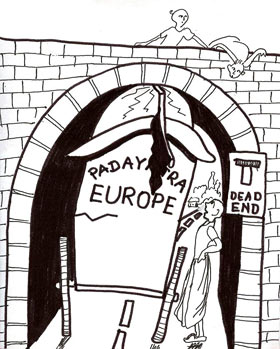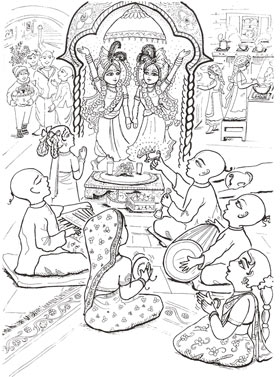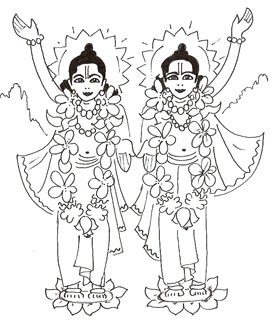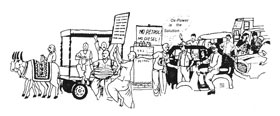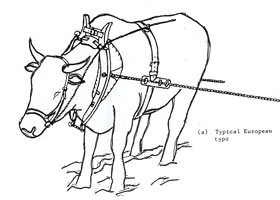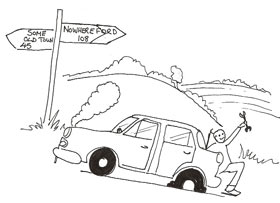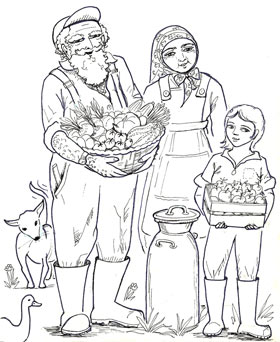HOW TO ORGANIZE AND MANAGE PADAYATRA
1 – SETTING UP AN OFFICE
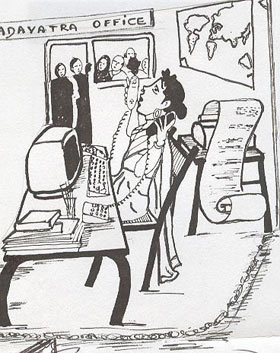 An office will be very useful, especially if you are planning a long walk or regular Padayatras. Any office will do, whatever you can manage -a desk in a room, the temple’s office, a van with a portable phone, or even a deluxe place.
An office will be very useful, especially if you are planning a long walk or regular Padayatras. Any office will do, whatever you can manage -a desk in a room, the temple’s office, a van with a portable phone, or even a deluxe place.
WHAT YOU NEED AN OFFICE FOR
1) Communication:
– An address to receive donations and important mail.
– A place for padayatra leaders to meet, think, brainstorm and organize things.
– An information center for participants, devotees, temple leaders, congregation, etc.
– A location for media people to meet organizers.
– A location to do all your mailings:
– Media packages.
– Information to interested devotees.
– Invitations and schedules.
– Thank you letters to officials and all the people who helped in any way.
– Letters of follow-up to friends, potential devotees and congregational members.
– Advantages of a phone:
– For preparations, advance party work, legal work, fund-raising.
– To assist Padayatra on the road.
– To inform devotees wanting to join Padayatra about the location of the walk, the festival, night accomodations, etc.
– Get one or two mobile phones also–perfect gadgets for padayatris on the move.
2) Production of printed materials:
Environmental considerations
-Wherever possible, print all materials on recycled paper and mention it in your publication.
Letters, invitations and posters
– The same standard letter can be sent with variations of text to various groups: officials, schools, police, department of transportation (giving route information), councils and mayors (detailing parade, venue and requirements, and requesting a meeting, time and location), congregation and Indians, media, businesses and wholesalers (they can donate goods), etc.
– All letters should be accompanied with: itinerary, Padayatra pamphlet and positive letters from other mayors and councils.
– Invitations and letters to VIPs.
– Invitations to fund-raising dinners, festivals, inaugural function and closing ceremony.
– Posters announcing festivals, the arrival of Padayatra in town, fund-raising events, benefit concerts, etc.
– Invitation to join programs at the Padayatra camp.
Appendix a:Sample letter to officials (New Zealand) 1990
Padayatra fund-raising brochure
Contents:
– Describe the spiritual significance of Padayatra and its various benefits to the devotees and the world.
– Introduce Srila Prabhupada as the modern inaugurator of this program, and H.H. Lokanath Swami as its worldwide leader.
– Write a short article on the history of ISKCON Padayatra.
– Add a few color photos of different aspects of Padayatra.
– Offer several categories for donors: grand patron, patron, every town and village club, etc.
Appendix b: Padayatra America fund-raising brochure (USA,1989)
Padayatra magazine for promotion and fund-raising
Contents:
– Lecture from Srila Prabhupada on preaching, Padayatra, duty of devotees to preach and distribute the holy name, etc.
– Interview with H.H. Lokanath Swami and other Padayatra leaders.
– Padayatra update: organisation, team, plans, devotees, etc.
– List sponsors: bhoga, utensils, accommodations, vehicles, ox plastic shoes, etc.
– Advertisement from businessmen who gave donations or sponsored some aspect of Padayatra.
Local Padayatra Newsletter
Contents:
– Article from H.H. Lokanath Swami Maharaja.
– Interview with Padayatra organizers and other participants.
– Poems, realisations, stories on the road, etc.
– Specifics about your Padayatra: schedule, route, etc.
– Information on how to join the walk (telephone numbers, shuttle vehicles, etc.).
– List of ways devotees can assist Padayatra and services they can render.
– Presentation of the feasibility study, finances and the budget.
– List of donors with “thank you†note and a personal comment.
Distribution:
– Send it free to all donors, potential helpers and participants.
– Make it regular.
Pamphlets for mass distribution
This is vital for every Padayatra to print and distribute cheap pamphlets and tracts on a mass scale. Not everybody will buy a book or get a magazine. This chance to make mass propaganda should not be missed. When will be the next time so many people in this part of the world will get to hear about Srila Prabhupada and Lord Caitanya?
Contents:
– Description of the Padayatra goals and programs (theme, chanting, cow protection, simple living, etc.).
– Brief introduction to the philosophy of Krishna Consciousness.
– Explanation of the maha- mantra and the benefits of chanting the names of God.
– Schedule of walks and main festivals.
– Information on “Food for Life” during the walk.
– Addresses and phone numbers of local temples, preaching centers, gatherings, restaurants, boutiques, etc.
– Address of BBT where people can order books.
– Add for the “Bhagavad gita as it is”.
– Optional: detachable coupon to get a free book or booklet.
Suggestions:
– In Slovenia devotees printed a small booklet in 4 languages (Slovenian, English, German, Italian) with the route, theme and purpose of the walk and contact address. The cost of printing was covered by commercial advertising on the back page.
Appendix c,d,e,f and g: Mass distribution pamphlets (UK, Australia, New Zealand, Canada and Slovenia).
Padayatra souvenir magazine
Contents:
– Photos of all aspects of Padayatra: leaders, oxen, VIPs, devotees, festivals, etc.
– Maps with the route.
– Scores and numbers: books, prasadam, pamphlets distributed, cities and villages visited, festivals held, newspaper articles, radio and TV interviews, meeting with VIPs, etc.
– Stories, poems, songs, plays, etc.
– Realisations of participants.
– Devotees and friends made during the walk
– Thank you section to all those who made it happen: donors, organizers, helpers, walkers, officials and the public.
– Children’s and adults’ drawings and illustrations.
Sankirtan clipboard
Contents:
– Short statement on the purpose of Padayatra.
– Theme of the walk.
– A few color photos: ox cart, Deities, camp, Food for Life, walkers.
– Optional: list of cities, mayors, churches, institutions who have already helped.
– Brief words of recommendation from above people.
– Favorable newspaper clippings, preferably from the same country.
Purpose:
– Support for:
– Book distribution.
– Collecting bhoga and other items.
– Advance party work.
– Contacting people in places where they will not see the procession.
Padayatra presentation folder
Contents:
– Same as the sankirtana clipboard but more expanded.
– Lots of photos of Padayatras, newspaper clippings from all over the world, map of the
walk, previous walks, etc.
– Suggested size: 30 to 40 pages, A4 size.
– Keep it in a plastic folder.
Purpose:
– Essential for advance party work.
Devotees information sheet and registration form
– Mandatory for all participants.
Purpose:
– To avoid any legal problems: thefts, accidents, etc.
– To make the management easier.
– To inform the leaders of who is on the walk.
– To know who to contact in case of disease, accident or death.
Legal waiver
– Official paper signed by the participants stating that Padayatra will not be held legally responsible for accidents and serious illness during the walk.
News package
– Refer to section 17 “Communicate, communicate, communicate”
APPENDIX
Sample letter to officials
a- Letter to Christchurch City Council (New Zealand, 1991)
Fund raising brochure
b- Padayatra America fund-raising brochure – part 1 | part 2 (USA, 1989)
Mass distribution pamphlets:
c- Hare Krishna Pilgrimage: On the road for change (UK, 1991)
d- Come and join our festival – part 1 | part 2 (Australia, 1992)
e- Walking for a change: Krishna Consciousness and the environment – part 1 | part 2 (New Zealand, 1993)
f- Hare Krishna Walk for Unity – part 1 | part 2 (Canada, 1992)
g- Eco Caravan: booklet in 4 languages – part 1 | part 2 | part 3 (Slovenia, 2002)
2 – ORGANIZE YOUR PADAYATRA
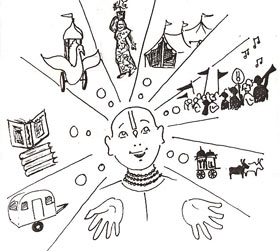 Mismanagement can really mess devotees up on Padayatra. It can be a very frustrating experience when the 12 km walk turns into a 30 km one, when prasadam is served very late, when the book distributors arriving late find out that nobody has saved them a bite to eat, or when the tents are not set up upon reaching camp after having walked all day in the hot sun. Of course these difficulties bring realisations, help one develop patience and tolerance, and at the end of the day all these inconveniences do not matter so much, they even provide good opportunities to laugh and joke. Noneless good organisation will make devotees happy and the preaching more effective. ISKCON provides excellent training for managers, so why not take advantage of it and register for Anuttama das ‘s course on Management?
Mismanagement can really mess devotees up on Padayatra. It can be a very frustrating experience when the 12 km walk turns into a 30 km one, when prasadam is served very late, when the book distributors arriving late find out that nobody has saved them a bite to eat, or when the tents are not set up upon reaching camp after having walked all day in the hot sun. Of course these difficulties bring realisations, help one develop patience and tolerance, and at the end of the day all these inconveniences do not matter so much, they even provide good opportunities to laugh and joke. Noneless good organisation will make devotees happy and the preaching more effective. ISKCON provides excellent training for managers, so why not take advantage of it and register for Anuttama das ‘s course on Management?
IDENTIFY THE GOALS YOU WANT TO ACHIEVE
1) Which style of Padayatra do you want?
– Single walker: one lone walker assisted by a support vehicle transporting him to accommodations and preaching engagements.
Ex: H.H.Bhaktimarga Swami.
– Harinam party: walking party with deities on a palanquin.
Ex: USA West Coast walk, Iceland.
– Simple procession: one Deity cart pulled by oxen, a small group of devotees, or a single family.
Ex: Parasuram’s party in UK.
– Large party and procession: hundreds of devotees, oxen, elephant, deity cart, children’s cart, festival tents, shows and exhibits, support vehicles, Food for Life vehicle, etc.
Ex: Padayatra India from 1984 to 1986.
– Walk and drive: walk only in populated areas and drive devotees, carts, oxen and equipment the rest of the way.
Ex: Australia.
– Walk and fly: harinam walk with deities on palanquin in one place (country, city or island), then flying to the next one.
Ex: Siberia.
– Walk and take a boat: harinam walks in villages and cities along the bank of a river or on
the coast of an ocean.
Ex: Carribean Islands.
2) Who is organizing Padayatra?
– One or several devotees
– One or several families
– One or several temples
– A national yatra or yatras from several countries
– An independent travelling Padayatra party
– Another group not related to ISKCON
Devotees have joined walks organised by other groups, religious (Pilgrimage to Assisi, Dindi Yatra, etc.) or not (The annual walkers group in Holland). Devotees can take advantage of the new trend of religious or secular walks and save themselves so much organizational trouble.
3) What are your objectives?
– Walk from one place to another in a fixed amount of time, and preach as much as possible on the way.
– Go from one location to another without a very strict schedule: cultivate friends and congregation and hold many home programs.
– Focus of intensive book distribution.
– Organise as many festivals as possible.
– Distribute prasadamon a grand scale.
– Cultivate many VIPs: officials, mayors, heads of institutions.
– Generate extensive media coverage.
– Visit many holy places, or temples.
– Make the walk a spiritual retreat for increased devotee association and sadhana.
– Promote cow protection and ox power.
– Establish or re-establish contacts with devotees living outside temples and members of the congregation.
– Unite a national yatraor temples on the same continent.
– Get a specific message across to the public: your main theme.
– Use the walk as a means to protest against injustices done to ISKCON devotees.
4) What theme to choose?
– Do you want a main theme and a secondary theme?
Ex: Srila Prabhupada’s Centennial was the main theme of Padayatra India from 1986 to 1996 and the main theme for all the walks done during the Centennial years, but they all had secondary themes.
– Consider how your theme will determine 2 aspects of Padayatra:
– Your communication strategy with the media
– The way you promote Padayatra (signs, banners, pamphlets, etc.)
Themes adopted by various Padayatras:
- Padayatra worldwide – Srila Prabhupada’s Centennial
- India (1986 to 1987) – Lord Caitanya’s 500th anniversary
- USA (1989) – Walk for religious freedom
- West Bengal (1994) – Universal peace and friendship
- New Zealand (1991) – Steps towards peace
- New Zealand – Walking for a change: Krishna consciousness and the environment
- France (1991) – Peace walk from Belfast to Moscow
- England (1991) – On the road for change
- Holland (1991) – Walk for higher consciousness
- Germany – Unity in diversity of mankind
- Denmark – Peace
- Iceland- Peace march
- Australia – Bringing Krishna to you
- Canada (1992) – Hare Krishna walk for unity
- Philippines – Steps towards peace and progress
- Iceland – Peace march
- Mauritius – Hare Krishna walking appealing for peace and against draught
- Brazil – Chanting against hunger and violence
- Malaysia – Propaganda Against Dadah Abuse (walk against drug abuse)
- Hungary – “ Soul to soul†– “we are not this body, we are spirit soulsâ€
- Holland (1998) – “Padayatra, a step in the right directionâ€
5) What is the duration and pace of your Padayatra?
Duration:
- A day – Protest walks (UK)
- A few days to one week – Annual Padayatra Week (Centennial year)
- A few weeks to a few months – Australia, New Zealand, etc.
- It is a yearly event – Mauritius, Slovenia
- It is a programme stretching to a few years – Padayatra America, Europe
- It is an ongoing programme – Padayatra India
Pace:
– Easy come, easy goes: take things as Krishna presents them
– Short walks, 5, 6 or 7 days a week: around 10 kms per day
– Longer walks 5 or 6 days a week: 15 to 20 kms per day
SPECIAL PADAYATRAS
1) Padayatra Week:
During the Centennial year, from April 21st to 27th, a week-long walking festival was observed simultaneously all over the world. The Global Padayatra week was one of the many centennial events, culminating in the World Holy Name Day. It was observed differently in different countries and temples: extended harinams in the vicinity of the temple, long distance walks, extended programs including cultural entertainments, prasadam distribution, reception by local VIPS, etc.
Everything was centered around the theme and helped publicize the celebration of the 100th birth anniversary of Srila Prabhupada, the founder-acarya of the Hare Krishna Movement: banners, posters advertizing the walk, hand outs and press releases.
Appendix a: The Padayatra week: a 1996 event
Appendix b: Padayatra week brochure.
Padayatra weeks after 1996:
A few countries got so inspired by the Centennial Padayatra week that they continued to organize one in the following years, making it a yearly event. It is up to each yatra to revive the spirit of the Centennial year and reap the benefits.
2) Protest walks:
Several protest walks were organized, all having a tremendous impact on the public, which resulted in a favourable outcome for the devotees:
– USA (1989 and 1990): Walk to save 7 US temples threatened in the Robin George lawsuit. Padayatra also organised a 24-hour prayer vigil in Washington D.C.
– Bhaktivedanta Manor (UK): walks to keep the Manor a place of worship accessible to thousands of worshipers.
Appendix c:Sponsor Dharma and save your temple (UK, 1991)
ORGANIZE YOUR MANPOWER
1) Who will participate?
– In order to make adequate preparations (vehicles, tents, accommodations, bhoga, etc.)
and to avoid wasting Krishna’s energy, evaluate the number of participants as exactly
as possible.
– Make a list of participants by considering the following groups:
– Full-time padayatris.
– Part-time padayatris: local devotees, those coming for week-ends only, etc.
– Visitors from other temples and countries.
– Friends and members of the congregation.
– Gurukula children.
– People from other groups.
-Take into consideration the days when there will be more participants: week-ends, holidays, special festivals, etc.
2) Which departments will you need?
– General manager or managing committee including department heads
Organization, vision and supervision, plan making and problem solving.
– Secretary or office workers
General correspondence, fliers, posters and invitations printing, minutes of
meetings, letter writing, Padayatra newsletter compilation, fund-raising follow-up,
telephone answering, permits, all other office work.
Duties are described in Section 1- Set up an office
– Kirtan and procession leaders
Duties are described in Section 16- Stage an attractive harinam and procession
– Advance party team
Duties are described in Section 11- Advance party.
– Fund-raisers
Duties are described in Section 4- Raise funds.
– Treasurer
Income and expenses records, financial reports, petty cash.
– Communication team
Contacts with the media, religious leaders and VIPs.
Duties are described in Section 17- Communicate
– Cart construction team
Carts design and construction.
– Animal department
Purchasing animals, training, vaccination, general care, ox cart driving.
Duties are described in Section 9- Oxen and other animals.
– Kitchen department
Kitchen equipment and vehicle, menus, dry and fresh bhoga supplies, cooking, etc
Duties are described in Section 13- Manage the kitchen.
– Food for Life
Bhoga, equipment, serving utensils, cooking, serving, etc.
Duties are described in Section 13- Manage the kitchen and distribute prasadam.
– Deity department
Deities, outfits, jewelry, storage of related paraphernalia, pujari services, etc.
Duties are described in Section 8- Invite Deities.
– Festival department
Festival tents and pandals, signs and banners, displays, dioramas and exhibits, theatre (plays and costumes), lights, sound system, etc.
Duties are described in Section 14- Organize festivals.
– Vehicle department
Purchase and maintenance of vehicles and trailer, insurance, mechanic, etc.
Duties are described in Section 10- Use motor vehicles.
– Accommodations
Purchase of tents and portable showers and toilets, setting up camp, etc.
Duties are described in Section 12- Accommodations.
– Security
– Make practical arrangements to ensure the security of the Deities, the devotees and Padayatra’s property: padayatris have been attacked by bandits and the mafia in Bulgaria, surrounded by guerilleros and robbers stealing everything from those they met in Mexico and Central America, a book distributor threatened at gun point in Bielorussia, horses stolen and Deities broken in Bangladesh.
– Get a team of strong men to keep watch.
– Guard the Deities’ cart and the animals at night.
– Make arrangements for safety while walking or driving the ox cart.
– Travelling store
– Sell devotional items to the public: books, clothes, CDs and cassettes,incense, photos, posters, etc.
– Sell Indian crafts: statues, boxes, jewelry, clothes, bedspreads, decorative items, etc.
– Provides devotional clothes, tilak, drinking water, snacks, flashlights, batteries, casettes, buckets, mosquitoe repellents, mosquito nets, mats, pens, etc. to the padayatris.
Appendix d: Organizational structure of Padayatra India (Jayadvaita Swami, 1984)
Appendix e: Padayatra yearly schedule (Maharashtra, India, 2003-2004)
3) How to organize your manpower?
– Make the list of services to be covered and match it with the list of manpower available.
– Before the walk: post the list of your needs in the Padayatra newsletter, on the temple board, etc.
– During the walk: post the list also on the Padayatra Information Board.
GET THE DEVOTEES READY FOR THE ROAD
Padayatra managers have to make sure that all the walkers are ready for the road, which has been greatly overlooked on most walks. In India during the 1986 walk, devotees were very poorly prepared: they had no mosquito nets, they were not equipped for the rainy season, had no raincoats, there was no covering for the deity cart, it was just open. One devotee almost lost his life in the Himalayas because he had no decent walking shoes, just flip –flops. In fact an entire article was written in a British newspaper about how the walkers were spaced out and very poorly equipped.
Refer to Section 17- Communication “Spaced-out in flip-flops on the way to Ripponâ€
Which personal items to bring?
– Proper clothes and equipment for the climate of the season: raincoats and boots, hats and sun protection lotions.
– Good walking shoes: flip-flops are convenient, but are not walking shoes.
– Personal tents, mosquitoe repellent, buckets, flashlights, laundry lines, etc.
– Strollers, snacks, toys for children.
Medical supplies:
– First aid kit for the party: basic medicines for burns, insect and snake bites, cuts, dehydration, colds, fever, etc.
What to think about?
– Educate the devotees about possible dangers : poisonous plants ( poison ivy, poison oak), dangerous insects and animals, possible landmines in countries that had been ravaged by war.
– Which vaccinations are mandatory to enter various countries.
– Have a vehicle always available to transport sick or seriously injured walkers to the nearest medical facility in case of emergency.
HOW TO MANAGE THE PARTY ON THE ROAD
The success of your Padayatra will be measured by the happiness of the devotees and the impact on the media. It will depend on how tightly the managing team and the padayatris work smoothly together and maintain good communication. These ingredients are essential in any regular temple, and they are even more required on the Padayatra program where life on the road is always full of changes, uncertainties, adventures and unpredictible events.
Communication at all levels will be maintained the following ways:
1) Short daily istagosthi:
Immediately after the morning class, hold a very short istagosthi to inform the devotees of relevant information and to ensure that all services are covered.
What all padayatris should know before the walk starts:
– The daily route, the itinerary of the parade through town, the number of kilometres of the walk (children might not walk the entire stretch).
– Location and duration of parades.
– Where and when prasadam will be served.
– The special events for the day: festival, home programs, media.
– Accommodations for the day, with address, telephone numbers and a little map if required.
– What services are to be covered.
Make a daily travel report:
The daily travel report would be filled out by the advance party and contain all the above information, plus some extra ones:
Date, place, number of kms to the destination, name of village or town, the size of the population, the place of residence, the contact person, the route, condition of road (good, bad or miserable), receptions, if any, and what you might expect at the reception, breakfast place if it was chosen and who is cooking – us or them.
– The advantage of having it printed is that it saves time, and it can be kept in the archives as souvenirs or used again by devotees if another walk is organized in the same area in the future.
2) Hold regular istagosthis:
Regular istagostis will strenghten the management team and unite t
he padayatris creating an atmosphere of cooperation, appreciation and mutual respect. Hold them at regular intervals, preferably on a rest day.
Suggested format:
– Inspirational talks about preaching, the benefits of Padayatra, Lord Caitanya’s lila, etc.
– The management team informs devotees of upcoming events and festivals.
– Problems and challenges are discussed, and solutions found.
– Department heads make reports of what is taking place in their departments.
– Devotees are invited to make suggestions and proposals for improvements.
– Devotees share realisations, adventures and nectar stories.
– Leaders organise mini-training sessions and seminars: ox care, book distribution, communication, instruments playing, kirtan and bhajans, etc.
3) Get an information board:
Daily post on the information board:
– All the above information (What all padayatris should know before the walk)
– Newspaper clippings
– Reports of encounters with the media
– Book scores
– Photos
– Lost and found
APPENDIX
a- Padayatra week: a 1996 event (SPC Ministry, 1996)
b- Padayatra week brochure – part 1 | part 2 (SPC Ministry, 1996)
c- Sponsor Dharma and save your temple – part 1 | part 2 | part 3 | form (Bhaktivedanta Manor, UK, 1991)
d- Organizational structure of Padayatra India (Jayadvaita Swami)
e- Padayatra yearly schedule (Maharashtra, India, 2003-2004)
Padayatra Fiji pamphlet – part 1 | part 2 (Fiji 1992)
ORGANIZATIONAL STRUCTURE OF PADAYATRA INDIA
(By His Holiness Jayadvaita Swami)
1. ADMINISTRATION AND LEADERSHIP DIVISION
- Padayatra party leaders
- Padayatra Managing Committee
- Padayatra General Manager
- Secretary
- Files
2. FINANCIAL DIVISION
- Budget Department
- Accounting Department
- Cashier
- Collections Department
a. Procession
b. Sobha yatra
i. Cash
ii. Fruits, flowers, rice, etc.
iii. Public exhibition
iv. Other
- Inventory Department
- Maintenance and Repairs Department
- Purchasing Department
3. SPECIAL PROJECTS DIVISION
- Special projects Department
4. PRASADAM DIVISION
- Kitchen Department
- Cooks
- Co-ordination with outside cooks and hosts
- Prasadam serving Department
- Servers
- Clean-up
- Public Prasadam Distribution Department
5. PERSONNEL DIVISION
- Padayatra Temple Commander
- Padayatra Department
- New Bhaktas Department
- Quartermaster
- Medical Department
6. ADVANCE AND POST DEPARTURE DIVISION
- Initial Contact Party
- Advance Party
- Reception Coordinator
- Village Relations Department
- Post-Department Party
- Village relations man
- Supervisor for breakfast-making, gear-loading, and site cleaning
- Site cleaners
7. TRAVEL DIVISION
- Animal Maintenance Department
- Bulls
- Camel
- Elephant
- Vehicle Maintenance Department
- Baggage Handling Department
8. PROCESSION DIVISION
- Padayatra Procession
- Sobha yatra Procession
9. PUBLIC EXHIBITIONS DIVISION
1. Public Exhibition Department
- Announcement
- Sound and Lighting
- Setting up and Breaking Down
- Book Booth
- Nama Hatta Booth
- Reception and Questions and Answers Booth
- Dioramas
- Photo Display
- Deity Worship
2. Stage Programme
- Emcee
- Kirtans
- Lectures and translations
- Book sales
- Movies
10. BOOK DISTRIBUTION DIVISION
- Supplies and Collections
- Distributors
11. PUJA DIVISION
- Deity Department
12. RECORDS AND COMMUNICATIONS DIVISION
- Newsletter Department
- Public Affairs Department
- Diary Department
- Photography Department
- Legal Department
13. SECURITY DIVISION
- Security Department
3 – DO A FEASIBILITY STUDY
 A feasibility study simply means putting down on paper, in an organized manner, what you plan to do and how you are going to do it.
A feasibility study simply means putting down on paper, in an organized manner, what you plan to do and how you are going to do it.
MAKE YOUR PADAYATRA SUCCESSFUL
A well prepared feasibility study will make your padayatra a success:
– It’s the most important part of your preparations.
– It will indicate whether you have done sufficient research and have carefully considered all the important details.
– It will convince yourself and others that what you are proposing is practical and feasible.
– It is meant to be presented to various ISKCON leaders (GBC, Temple Presidents, etc.) to get their support and blessings of Padayatra.
– It will force you to confront many kinds of problems and find solutions in advance.
WHAT YOUR FEASIBILITY STUDY SHOULD INCLUDE
– Padayatra organization outlines
– Legal considerations: permits, insurance
– Budget: initial and on the road
– Fund-raising strategy
– Realistic plans for self-sufficiency
– Inspiring padayatra theme
– Manpower projections
– Route and schedules
– Organization of the procession and security
– Plans for accommodations and sanitation
– Festivals and home programs
– Book distribution plans
– Preaching strategies
– Communication strategy
– Plans for carts and vehicles
USE IT IN MANY WAYS
 1) Distribute it widely:
1) Distribute it widely:
– Various administrations
– ISKCON leaders and devotees
– Potential helpers
2) Great tool for fund-raising:
– People are more inclined to give when they see something serious and organized.
Appendix a:
New Zealand feasibility study for the North Island (New Zealand,1993)
FEASIBILITY STUDY
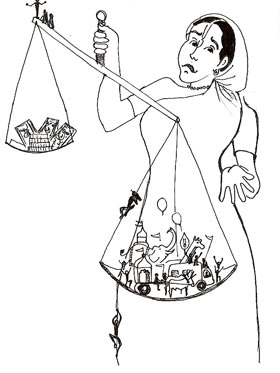 REVISED PROPOSAL FOR NORTH ISLAND PADAYATRA FOR 1993 (Jan.-Febr.)
REVISED PROPOSAL FOR NORTH ISLAND PADAYATRA FOR 1993 (Jan.-Febr.)
Introduction
This short paper is designed to present some ideas for inspiration, feedback and discussion as to how Padayatra in the North Island can practically take place. It has been prepared under the guidance of His Holiness Lokanatha Swami and its format follows a suggested approach laid out in the Padayatra handbook.
After much thought and discussion concerning how to best continue Padayatra in New Zealand, the outcome is that the same style of program as was conducted in the South Island with some suggested improvements should be continued in the North Island.
The idea is that this large festival style of Padayatra compromised with driving over the long distances is a good way to gradually introduce the walking concept and break the ground for the increasing use of the bullock cart.
In the year to come it would be most pleasing to Srila Prabhupada to see many such ox carts on the road and to every town and village, but also that every household in the countryside receives the mercy of Lord Caitanya. To achieve this, the most austere devotees will actually walk the distance and, as suggested by Lokanatha Swami, the day will come when family groups will be on the road. Ox cart preaching is catching on. It is exciting. Until that time, let us push on.
I am sure that we would all like to see Padayatra continued and not only until 1996 as a celebration of Srila Prabhupada’s 100th anniversary, but also as an eternal front line in the sankirtana army. As Srila Prabhupada said, “I have built the framework, it is up to you fill it in.†Let us begin by launching Padayatra North Island with fresh zest and enthusiasm to overcome any obstacles that maya presents to check its success.
Primary Theme
Dharma-Bhumi – Walk to save the Earth (or any other alternative slogan that will be decided upon.)
This is a godd opportunity for ISKCON to catch the wave of current concern over man and his environment. Society at large, particularly in the so-called advanced western world, are feeling increasingly threatened by depletion, not only of their pious activities but also of the natural resources that they have ruthlessly plundered. “It’s not like the old days,†thay say. The forests have gone, the mountains are no longer peaceful, even the farmer lock their doors and in the cities, security is undermined by the cancer of social ills.
They say New Zealand is one of the last frontiers where nature holds its own and at least a tinge of the mode of goodness still exists. The proud “Kiwis†are keen to keep it that way. Stop gap institutions like “Green peaceâ€, “Nuclear freeâ€, and “Keep New Zealand Green†have jumped on the bandwagon of conservation issues. Their answers are superficial and achieve no more than “stick a finger in the hole of the dam†of overwhelming problems. Only the Vedic science can solve these basic disorders. Of course, these matters are not our primary concern but because they are very topical in the “90’sâ€, this is a good chance to allow Krishna to become the centre, and perfect order will follow.
This theme would be our entry like the needle. The heavy artillery could follow in disguise. This subject would capture the interest of the people; young and old, conservative and progressive, could all relate and why not take the lead in the field of conservation and resources, preservation of environment and protection of peaceful lifestyle? ISCKON can give the answers and it is the brahmanas‘ duty to teach through
- cow protection
- varnasrama institution
- prasadam
- etc.
Secondary Theme
A secondary theme could also be developed of the Auckland Yatra’s choice e.g. “He built a house in which the whole world could live†– the building of Bhakti Bhavan. This could be exhibited in a separate section in displays.
Format
- Exercising a similar concept to South Island “Steps toward Peace†festival i.e. Bullock cart (same as used in South Island pulled by two bulls) and carry a murti a Srila Prabhupada, Sri Sri Nitai-Gaurasandara Deities – approx. 100cm to be carved in New Zealand – marble feet of Lord Caitanya and painting of Panca-Tattva.
- Accompanied by devotees and enthusiasts walking in typical Padayatra style i.e. kirtan with banners, book and prasadam distribution. Walking would be done on the footpaths and bullock cart would travel on the road.
- Suitable planning would be made to increase the amount of walking otherwise the same method of walking in populated areas and driving vast areas of unpopulated rural area. This involved trucks transportation for bullocks, vehicle trailer for cart and bus for devotees. However, because devotees enjoy the outdoor environment, some choice areas will be selected for walking in the peaceful countryside.
- Conscious effort to spend more time in the larger towns and cities where response and preaching potential is good.
- Suitable camping could be arranged in off the beaten track areas for the pleasure and association of devotees in a retreat-like atmosphere.
- Major festivals would be pre-arranged with suitable hall facilities for preaching to large numbers of guests.
- Some outdoor carnival-style program would be scheduled in holiday resorts, using tents, pandals, etc.
- All effort would be made to contact important personalities and include them in ceremonial functions and celebrations i.e. Dame Cath Tizart (Governor-General) for inauguration and mayors in all towns where parades would take place.
- Schools and other organizations, clubs, etc. can be approached to give audience and participate in festivals. Our own gurukula could entertain with puppet shows, plays, etc.
- Special emphasis would be given to communicating and informing all media contacts.
Proposed Route
Because of the larger number of towns and more peopled preaching fields of the North Island, it is decided to cover the area more efficiently and effectively by spreading it out over 2 years. The program of summer 1993 would include a schedule of 6 weeks to complete a circuit a follows: Auckland, Whangamata, Tauranga, Mt. Manganui, Whakatane, Gisborne, Napier, Hastings, Taupo, Rotorua and Hamilton. The program for the summer 1994 would include Wellington, Palamerston North, Wanganui, New Plymouth, and continue on above Auckland to complete the North Island section. As Padayatra is designed to reach out to every town and village, all significant size towns in between can be included to receive a taste of Lord Caitanya’s mercy.
Manpower
Primarily most of the devotees participating and exercising the North Island Padayatra would come from the Auckland Yatra. This would obviously be organised in consultation and agreement with the Temple Management, making sure that existing projects and Deity worship are continued and maintained nicely. Indication has been given that devotees from Christchurch and Wellington would also take part. Groups of devotees would alternate in accordance with gaining the association of their own spiritual masters for the period of time that their guru plans to stay on Padayatra. Some devotees may also make arrangement to stay for longer periods of time depending on the wishes of their authorities. Extensive welcome will be made to devotees from other parts of the world who would like to join.
There would have to be a hard core of designated devotees responsible for keeping the show on the road. Responsabilities would be spread out, dividing the management into different departements with specific experienced leaders in charge. Please refer to ‘Appendix’ with suggested list of allotment of management responsabilities.
Sannyasis
It is essential to have at least one sannyasi travelling with the party at all times. Sannyasis that are invited must be notified of the program as soon as possible so that they can plan accordingly and fit into the schedule at suitable times. Please refer to ‘Appendix’ with suggested list of sannyasis.
Fundraising
- G.B.C. representative could promote the benefits of Padayatra – special classes to devotees and public or Indian community to raise Padayatra consciousness and direct request for donations.
- Mail-out to Life members presenting the program in a package containing a brochure, a personal letter from a senior devotee, a pledge card and a return pre-paid envelope.
- Sales – garage sale, special bake sales, T-shirt and Padayatra souvenir sales.
- Benefit shows and concerts. Artists, dancers and musicians performing for fundraising purposes. Puppet shows for children.
- Fundraising dinner at Gopala’s Restaurant inviting friends, devotees, and Indians. First class prasadam should be served and entertainment should be provided so a good cover charge can be made on ticket sales.
- Paraphernalia collection.
- Suggestion on raffle ticket selling with a trip to India as prize.
- Advertising in FOLK magazine.
- Encourage sponsorship from large companies, especially donations of produce.
Major vehicles required
- Van to tow trailer with cart.
- Truck or float for transportation of bullocks.
- Converted bus or caravan for accomodation of senior devotees and sannyasis.
- Mobile kitchen for devotees prasadam, programmes, festivals, etc.
- Bus transportation for devotees and their luggage, who do not have their own vehicle.
- Car for transportation of books and mobility for book party.
- Car for transportation of sannyasis.
- Separate vehicle or bus for gurukula if necessary.
Deities
Small functional Deities of Gaura-Nitai (Utsava Deities). Larger wooden Nitai-Gaurasundara Deities – small Deity of Srila Prabhupada, small Jagannatha Deities.
N.B. The addition of larger wooden Deities is advised by H.H. Lokanath Swami. They will not be installed but maintained also as festival murtis only.
Other Specialized Considerations
- Cooking: An army runs on its stomach. All support should be given to the managers of this department to see that sufficient assistance, bhoga and cooking facilities are available.
- Oxen : Acording to experience and observations of other Padayatras, the most difficult problem to overcome is the shoeing, maintenance, and welfare of the animals’ feet. Careful consideration should be given to this aspect. Also the loading and off loading should be given special attention.
Book Distribution
This is definitely one of the most important aspects of the Padayatra and so needs a most qualified leader and a team of trained distributors whose sole attention should be towards this service. Leader must be capable of deciding the best areas to be worked for book distribution and must be able to organize book distributors for maximum coverage of area. He is also in charge of the collection of laxmi. Scores should be announced daily for the pleasure of Their Lordships and Srila Prabhupada. Decisions of methods of books distribution to be used should be made before Padayatra program begins i.e. books to be sold, given out, etc.
Food for Life
No sacrifice is complete without prasadam distribution – sweet distribution during parades and methods of other prasadam distribution at random could also be achieved.
PROJECTED BUDGET
Accomodation – 1600
Bhoga – 10000
Bulls – 1200
Cart – 500*
Deities – 2000*
Displays – 3000*
Flags, banners, etc. – 1000*
Fund raising – 1000
Hall hire – 1000
Insurance – 800
Kitchen Equipment – 1000
Miscellaneous – 2000
Photography – 1000
Postage, Admin. – 1000*
Printing – 500*
Promotion – 500
Travelling Expenses – 5000
Video – 500
TOTAL – 33600
*Cost covered by Christchurch Yatra amounting to $8000. Reminder to be covered by Auckland Yatra amounting to $25,600.
APPENDIX
Suggested allotment of Managerial Activities
- General Manager – Oversees whole operation. Should be mobile and aloof from all other engagements. Also sees to the hosting and transportation of sannyasis. Must have own car.
- Padayatra Co-ordinator – Supervises walks and parades. Organizes Padayatra program on day to day basis. General troubleshooter.
- Advance party (2 men) – Locates and arranges for accomodation for whole Padayatra party. Locates and arranges for halls where program will be held. Scouts out for suitable camp sites and outdoor festival areas. Determines suitable routes for walks and parades. Discusses and co.ordinates with Ministry of Transport and other City authorities. Communicates closely with Padayatra co-ordinator.
- Preparation secretary – Handles all legal comunications i.e. Requesting permission from councils: informs Traffic Dept. by mail etc. Contacts and invites all dignitaries and special guests invited to meet with Padayatra i.e. Mayors etc. Makes all initial contact with media outlets.
- Book Distribution Supervisor – Commands book party. Maintains book supplies and their transportation. Manages laxmi, book scores etc.
- Head Pujari and Assistant Pujari – Supervises worship and care for Deities. In charge of paraphernalia and supplies. Organizes offerings and arotiks. Staus with the Deities at all time.
- Care and Management of Oxen (2 people) – Sees to welfare of bullocks. Responsible for transportation of animals. On loading and off loading etc. shoeing, grooming and feeding. Sets up yokes and harness arrangement. Guides and walks animals during parades.
- Cart Supervisors (2 people) – Organizes transportation of cart by trailer, off loading and on loading etc. Sets up canopy and sides of collapsible done. Cares for the marble forms of Lord Caitanya’s lotus feet and painting of Panca Tattva. Assist pujari in securing Deities in position. Liasons with bullok supervisor. Rides on cart and manages brake.
- Head Cooks (2 teams of 2 people each) – Will oversee all main cooking and cleaning department. Designates all kitchen duties, engaging all participating devotees to help.
- Promotion Agent – Organizes posters, flyers and brochures.
- Kirtan Supervisor – Cares for instruments and supervisors kirtan leadership.
- Campside layout Commandor – Organizes who camps where, keeping matajis and prabhus suitably separate. Sees that sannyasis have privacy. Positions temple and kitchen in suitable place. Inform devotees of toilet, bathing and water source facilities. Organizes laundry arrangements i.e. where to place clotheslines etc.
- Gurukula Charge – Controls children. Cares for welfare, transport and accomodation of children. Organizes special activities and engagements.
- Shop Manager – Responsible of stocking and sales of mobile shop.
- Displays Officer – Sets out and packs up displays, decorations, dioramas and banners for all programs and festivals. Also sees to their transport and care.
- Food for Life Organizer – Distribution of sweets during walks and parades and other random prasadam distribution. Organizes devotees to make sweets for distribution.
- Driver of Errand Van – Buys bhoga and works in with head cook and pujari Dept.
- Other responsabilities will be determinated as required i.e.luggage handlers, bus drivers etc.
SANNYASIS
Suggested sannyasis to invite to Padayatra:
Lokanath Swami, Prabhavisnu Swami, Indradyumna Swami, Ramai Swami and Suhotra Swami.
4 – RAISE FUNDS AND MANAGE YOUR BUDGET
Money is the honey. Some laksmi is required on Padayatra, even if you go the avadhuta style with no planning and total dependence on Krishna. Srila Prabhupada wanted Padayatra to be self-sufficient, not depending too much on outside help but emphasizing on preaching and book distribution.
PROJECT YOUR INITIAL BUDGET
– Do it in a professional manner: that is the part of the feasibility study which ISKCON leaders will first turn to.
– Get the help of an accountant, if possible.
– Present a clear lay-out: figures must be neatly columned, labelled correctly and arithmetic must be correct.
– Show that you are responsible enough to receive and manage funds properly.
– Do not worry if your predicted costs are not exactly what they’ll turn out to be; of course they should not be too exagerated or underestimated.
– For estimates, consult experts in the various fields, professionals or devotees.
– Include your plan for becoming self-sufficient.
MAKE AN ACCURATE BUDGET
– Make a list of what you need: initial investment and laksmi needed for maintenance on the road .
– Make a separate weekly budget sheet including projected income and expenses:
– Deity supplies: bhoga, flowers, etc.
– Cart: maintenance and repairs.
– Animals: food, transportation, shoes, health.
– Vehicles: gasoline, maintenance, repairs.
– Kitchen: bhoga, propane, fuel, plates and cups for guests.
– Sankirtan: fliers, books, clipboards, etc.
– Communication: phone, copies, postage, faxes, etc.
– Devotees maintenance.
– Accommodation expenses : camping fees, rents, tents, etc.
– Check all the items that can be borrowed, donated or obtained at a cheaper price.
– Inform the devotees and the congregation of what you need.
– Post it on your community board.
– Include it in your local or national ISKCON publications.
– Present it to congregational members: businessmen, merchants, etc.
– Investigate what you can get sponsored in exchange for some kind of publicity: rubber shoes for oxen, Food for Life vehicle, festival tent, etc.
– How to make and use your budget sheets?
– Make a list of all the items you’ll need before and during the walk.
– Make a separate column for items donated, loaned or sponsored.
– Make 2 columns, one for items needed initially (II) and items needed on the road (MC).
– Keep in mind that some items will belong to both categories:
II = Initial Investment
MC = Maintenance cost or regular expenses during the walk
– In the column “Donated”, include the items that can be donated easily during the walk. You will thus have a better idea of how self-sufficient you can become.
MAKE YOUR PADAYATRA SELF-SUFFICIENT
– It is possible, study how others did it:
– Padayatra India became self-sufficient through book distribution.
– A Canadian Padayatra ended up with profit through successful home programs and sponsorships from the Indian congregation.
– Your plans for self-sufficiency should be realistic and take into consideration the size of your group, the duration and style of your Padayatra, time and place. What works wonders in a specific country may proved very difficult in another one. The mercy of Krishna is always there but you never know how, when or through which persons it will come.
Items donated during the walks around the world:
– Bhoga: dry goods, fruits and vegetables (shops, farmers, local population).
– Flowers for garlands and decoration for the Deities.
– Animals’ needs: feed (grass, hay, etc.), shoes, veterinarian services, decorations.
– Propane for kitchen tanks, wood for campfire and cooking.
– Deity clothes and paraphernalia.
Sources of income on Padayatra:
– Book and magazine sales.
– Prasadam sales can be done along with free prasadam distribution.
– Travelling store (Indian crafts and clothes, jewelry, devotional paraphernalia, walkers’ needs) are always popular.
– Donations received during home programs and festivals.
– Entrance fees received during major public festivals.
– Donation box(es): secure them safely to the cart to avoid theft, and empty them regularly.
MANAGE YOUR BUDGET EFFICIENTLY
– Designate an accountant to regularly fill out the budget sheets, in order to know exactly what your income and expenses are and how they balance.
– Have an efficient treasurer on the road:
– Keeps accurate accounts.
– Makes regular financial reports.
– Handles petty cash.
Note: It is highly recommended to keep BBT laksmi separate from other funds.
HAVE FUN RAISING FUNDS
1) Do fund-raising in a temple or at a home program:
This is how most of the funds were raised for Padayatra America in 1989 and for Padayatra Europe in 1990.
Prodedure:
– Assemble as many devotees as possible favorable to Padayatra.
– Best to have His Holiness Lokanath Swami Maharaja present, all your Padayatra organizers, and devotees who organized Padayatras before in the same country or other places.
– Make a general presentation of Padayatra, explaining all its wonderful and exciting features for the devotees and the public.
– Show the Padayatra Video or have a slide show.
– Give a short talk on the plans you have and what funds are needed.
– Make the feasibility study available in advance.
– Set a specific target to be achieved during that fund-raiser.
– Ask a person to donate the entire amount, and then gradually ask more people to give smaller donations until the target is reached.
– Ask donors to make realistic pledges, not to be carried over by the enthusiasm of the moment (keep in mind that all your pledges will not be realized).
– As a variation you might want to set up several categories of donors: Grand
Patron Member (ex: US$ 10,008), Patron (ex: US$ 1,008), Every Town and Village
Club (ex: US$ 108), etc
– Have a special incentive or gift for the donors: Padayatra T-shirt, Padayatra hat or bag, bottles of holy water, etc.
– Say a few sincere words of thanks to each donor, be personal, take your time, don’t rush, that is the secret of success.
– Give each donor a warm applause and a pledge form to fill out right away.
– Have devotees hand out the pledge forms along with pens and collect them afterwards, making sure that they are properly filled out and writing is understandable. – Remember to thank and give credit to all those who did not give any laksmi but were assisting with the fund-raiser and Padayatra in general.
Follow-up:
– Do a steady follow-up on the pledges made:
– Send a thank-you letter to all the pledgers, those who already gave their donation and those who plan to do it later.
– Tell them clearly how to give or send their laksmi.
– Be sensitive and encouraging with those having difficulties realizing their pledge.
– Keep reminding them in a gentle way how Padayatra is depending on themand the pledge they made.
2) Do a mail-out:
– Make a list of people selected from various sources: initiated devotees, congregational members, persons favorable to ISKCON and Padayatra, etc.
– Check out with other devotees for already existing lists: temple mailing list, guest book, Life Membership list, etc. Make sure you get their permission to use it!
– Mail everyone a package consisting of:
– A personal letter by a senior respected devotee explaining the spiritual significance of Padayatra and asking them to comply with one of the categories of donors found in the brochure
– A brochure containing practical information, interesting photos and offering some fund-raising schemes for the reader to fit into: Grand Patron Member, Every Town and Village, etc
– A pledge card to be filled out with name, address, amount given or pledged
– A return pre-stamped envelope for them to mail out their filled out pledge card and cheque to the Padayatra office.
3) Organize fund-raising dinners:
– Invite as many people as possible to a fund-raising dinner in your temple, your local Govinda’s restaurant, a rented hall, someone’s spacious home or garden, etc.
– Get as much bhoga as possible donated by devotees, local merchants, Indian shopkeepers, farmers, etc.
– Make prasadam and the presentation first class so the price of the ticket can be high enough to make your endeavor worth the trouble.
– Plan some kind of entertainment: Indian dance and music, bhajans, plays and sktetches, slide show, Padayatra video, etc
Appendix a: Pledge form for a Padayatra benefit dinner (U.K.)
4) Make appeals in ISKCON publications:
– Put an article about Padayatra and your plans in various ISKCON publications: temple newsletter, Hare Krishna World, local Padayatra newsletter, etc.
– Include some pictures and an appeal for funds and general help as in the mail-out (donor categories and detachable pledge form to be returned to you)
5) Organize various sales:
– Prasadam sales during the Sunday feast
– Padayatra T-shirts, bags, hats, etc.
– Indian crafts, clothes and jewelry
– Garage sales: ask devotees, congregation, friends and neighbours to empty their closets and attics from all unwanted items. This can be very lucrative!
6) Organise benefit shows and concerts:
– Get some talented devotees, members of the congregation and friends to perform for free or low cost and charge a reasonable admission fee for the program: concert, dance, magic show, puppet show, drama, etc.
7) Do a raffle:
– Get devotees, friends and merchants to donate the prizes to win.
– Make a list of all the prizes with the names of the persons who donated them and post it on the temple community board.
– Sell as many tickets as possible.
8) Don’t forget the most important item: saying “Thank you!”:
Any gentleman or lady, what to speak of a devotee of the Lord, will always remember to use these two magic words, “Please” and “Thank you”. We tend to remember and use the first one, as it opens many doors and financial opportunities for us, but once we get what we want, we tend to forget to say the second magic word “Thank you”. We are thus foolishly closing doors that could open again in the future. Any good salesman would never make such a mistake if he wants to keep his clients. How much more should we be careful and considerate in order to keep Krishna’s clients happy and satisfied?
We are all aware of the old saying that a happy customer always comes back for more.
Say “thank you” more than once, with all sincerity and in many different ways:
– Give your donors and helpers some recognition, genuinely and happily.
– During the fund-raising itself.
– Personally when you get a chance.
– Officially: Padayatra newsletter, and other publications.
– Be equally appreciative of the small donors and the big ones.
– Give some small (or large) gifts as a token of appreciation: they will appreciate the gesture as much as the gift itself, even if it does not cost much.
– Always send thank you letters after receiving each donation.
APPENDIX
a- Pledge form for Padayatra benefit dinner (UK,1991)
5 – DEAL WITH LEGALITIES
Padayatra involves many legal considerations. Various permits have to be obtained and local laws have to be examined and considered ahead of time. Obviously specifics will vary from country to country, and even from State to State in the same country. Once again, prevention is better than cure. Contact peace marches in your area. They can give information and practical and technical assistance.In the US, there is a group called Seeds of Peace, whole sole activity is assisting and giving advice for peace walks.
CREATE A NON-PROFIT ORGANIZATION
It presents many advantages:
– If Padayatra organizers are raising funds independently of temple administration, the non- profit organization status gives them facility to legitimately bank donations and enjoy other non-profit priviledges, like issuing tax-exempt receipts, etc.
– Vehicles can be insured under this non-profit organization.
– In case of an accident or a law-suit against Padayatra, ISKCON will not have to bear the weight and its non-profit status will not be affected.
GET ALL YOUR PERMITS AND LEGAL DOCUMENTS
1) Permits:
– Walking in procession on the streets and sidewalks through towns and cities (Check if it is legal to walk on the bike path when there are no sidewalks.)
– Driving ox carts or horse carts on public roads (Find out which ones, as it is
forbidden on highways and fast moving roads).
– Distributing books and prasadam.
– Collecting donations.
– Holding festivals.
– Carrying large signs and banners.
2) Legal documents:
– Vehicle insurance for all vehicles and trailers under the name of Padayatra or private individuals.
– Update vaccination certificates for the animals, when going from one town, state or country to the next (Animals could be kept in quarantine at the border).
– Insurance for the animals on the road in case of accident or injuries
– Valid driver’s license for devotees driving cars, vans, buses, trucks or motorcycles(Check these in advance).
– Personal identification papers for all participants.
– Valid passports, visas and permits for foreigners ( In Bulgaria the devotees had to leave the country as they were not registered with the police).
3) Other documents:
Written permission for minors:
Make a policy to admit minors on Padayatra only with the parent’s written permission.
Waiver for all participants:
All walkers will sign waivers giving up their rights to sue Padayatra if some accident occurs to them . This was done in peace marches. If no walkers break the law, and stay in legal areas, then Padayatra can in no way be responsible for accidents that occur directly or indirectly to the marchers.
The waiver should include who to contact in case of an accident, and the specific medical problems of the individual.
4) Practical considerations:
– Applying for permits must be done sufficiently in advance, as it might take a few weeks or months to get them.
– Padayatra organizers should keep the original permits and give copies to the devotees who will need these permits:
– Procession leader
– Sankirtan book distribution leader
– Ox care taker
– Communication team
– Advance party crew
– Individual devotees should always have an ID on them.
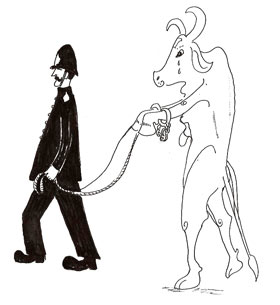 DEAL WITH THE POLICE AND VARIOUS AUTHORITIES
DEAL WITH THE POLICE AND VARIOUS AUTHORITIES
1) Deal personally with them:
– Inform them of your plans in details:
– What the procession will consist of: carts, animals, people, banners, loudspeakers, etc.: be very specific and accurate as far as numbers go
– The route to be followed
– The exact schedule of events
– Give them the name of the leaders (and mobile phone numbers) and other devotees responsible for different areas (security, permits, etc.) and, if possible, introduce these persons to them.
– Ask them to escort the parade through the town, what is the best route, etc.
2) They are here to help you:
This might not always be the case, but in most countries the police have been very helpful, protecting the padayatris, and making their walk easier in many ways:
– Providing an escort for the parade.
– Suggesting better routes and places for accommodation.
– Helping the devotees to find a lost animal.
– Giving a lift to book distributors who have tagged behind.
DON’T OVERLOOK IMPORTANT DETAILS
1) Noise restriction:
– Consider the neighbours if you plan to have an enthusiastic mangal-arati outdoors or close to private habitations.
– Inquire about the legal hours to make noise: in some countries it is illegal to make noise before 6 am.
2) Cart escort:
– For the safety of the procession, devotees escorting the cart and controlling traffic should wear very bright safety jackets and specific signs (Stop! Slow down. Slow vehicles, etc.).
– In some cities, a police escort is mandatory.
3) Damages caused by animals:
We do insist that you get an insurance as Padayatra will be held responsible for the damages caused by the animals:
– Destruction of private property:
– Rampaging a farmer’s field.
– Destruction of property (Laksmi, the elephant on Padayatra India, smashed a boat and other items, which the devotees had to pay for).
– Injury caused to individuals.
APPENDIX
A few short stories from the road
– In Serbia, after the padayatris had been given free access through all the toll roads on their way back to Greece, they were stopped by the police for driving too fast. But the policemen dropped the fine as soon as they saw the padayatra pamphlet with the maha-mantra on it.
– In Mexico, a friendly policeman even exchanged his police badge for a japa!
– One time in UK the police were there on horseback to escort the parade through town. When the horses heard the kirtan, they started to make these tracking steps, dancing to the tune. The policemen could not control their horses any longer and they were starting to fall off, quite a funny scene it was. Finally they asked the devotees to stop the music and chanting so they could continue their job!
6 – SELECT THE ROUTE
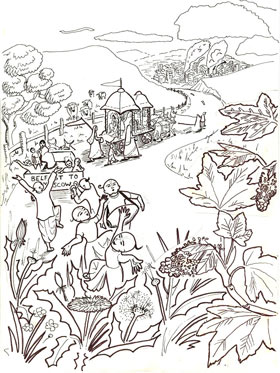 Not much fun for the devotees if the cart gets stuck in a tunnel or if they have to walk 10 extra kms because of poor planning. The main service of the advance party is to drive the entire route from start to finish. Every inch has to be checked for its suitability for walkers and carts.
Not much fun for the devotees if the cart gets stuck in a tunnel or if they have to walk 10 extra kms because of poor planning. The main service of the advance party is to drive the entire route from start to finish. Every inch has to be checked for its suitability for walkers and carts.
CONSIDER ALL THE IMPORTANT FACTORS
1) Time factor:
– How much time do you have for the walk?
– Will you walk the entire route in one stretch, or continue later?
– Do you have to be at a particular point at a specific time? Large functions and festivals have to be planned and advertised well in advance, so you’ll have to stick to your planned schedule, drive the walkers there, or mess up your plans.
– Make a detailed schedule including walking days, rest periods, festivals, etc.
– Plan a reasonable daily walk for the kinds of participants you have, the average daily walk being around 8 miles (14 kms).
2) Legalities related to the procession format:
– Harinam with palenquin on country roads and city streets: permission might be required.
– Procession with carts and oxen: make sure it is legal to drive the carts on the road you’d like to take. Slow moving carts may not be allowed on fast or narrow roads.
3) Number of people you’ll meet:
– You might want to take a detour or a longer route to go through big towns and cities and encounter more people.
– Your priority might be on the contrary to avoid large congested cities and go through small villages.
4) Special events taking place:
– Select your route as to include Vaisnava festival and/or public events taking place in the area (bicycle races, parades and carnivals, fairs, special shows, football matches, concerts, etc.)
– Prepare for an alternative plan: instead of having the entire Padayatra party walk to the location, leave the carts and oxen behind and drive the devotees in vehicles to the festival location.
– The authorities delivering permits can suggest an alternative route.
5) Weather conditions and topography of the roads:
– Will it be cold, damp, searing hot and rainy on the route you choose?
– Will it be flat, hilly or mountainous?
– Will the roads be in good shape or very rough, full of potholes, etc.?
– The factors listed above will determine how fast the animals will pull the cart and how many kilometres can be covered on that stretch of road.
Be aware in advance of the obstacles you might find on the road the day you will walk there, and plan a detour route:
– Special events blocking the road
– Road construction
– Bridges or passages with low overhead clearance: measure the height and width of the cart ahead of time (carts got stuck in Ireland and UK)
In areas where there are difficulties or it is too dangerous, just a few devotees could walk.
DRIVE THE ENTIRE ROUTE FIRST
This is the main service of the advance party:
– Drive the route in a car from beginning to end.
– Write down the exact mileage beween different cities and villages.
– Take note of the road condition, construction, etc.
– Inquire from the local population and officials about public events or planned road repair in the area.
– Make an accurate map for the procession leader:
– Chalk out a continuous route.
– Write down the names of the roads and streets where you wish to turn.
– Indicate the names of all the villages, towns and cities
– Add the location of the accommodations, festivals, etc.
– Match the walking schedule with the itinerary on the map.
7- DESIGN AND BUILD CARTS AND PALANQUINS
What makes Padayatra distinct from a regular harinam party is the Deity cart pulled by oxen or horses. In various parts of the world devotees have proved very imaginative and artistic in designing and decorating their travelling temple for the pleasure of the Deities and the public.
PALANQUINS AND / OR CARTS?
1) Advantages of a palanquin:
– Carts might not be adequate for the country, the roads, or the style of your Padayatra:
– On mountainous narrow roads.
– In some Muslim countries.
– For a simple Padayatra with only a few devotees.
– Even if you have a regular Deity cart, you can also use a palanquin to take the Deities on harinam in busy narrow streets or in a location where oxcarts are not permitted (downtown areas).
– For the Deities’s comfort and security, install a waterproof back side and a roof to your palanquin to protect Them from rain and sun (Choose a cloth that does not fade in the hot sun).
Appendix a: Color photos of various styles of palanquins.
2) Deity cart:
– The Deity cart, especially when driven by oxen, is the main attraction for the public: make it unique and eye catching!
– The Deity cart is also a travelling temple from which Sri Sri Nitai Gaurasundara will bless the fallen souls: make it beautiful, colourful and functional.
– The Deity cart can be pulled by oxen, horses, devotees, or even a car.
3) Children’s cart:
A second cart has proved very convenient in many walks for:
– Transporting children and tired walkers
– Carrying books, prasadam and fliers
– Carrying walkers’ belongings: bags, coats, raincoats, snacks, water, (which otherwise would usually end up cluttering the Deity cart).
– Storing items donated during the walk: fruits, flowers, hay, vegetables, etc.
– Storing the luggage of devotees joining Padayatra in the middle of the walk.
WHICH DESIGN TO ADOPT FOR THE DEITY CART ?
1) Use your creative imagination:
Padayatras around the world have used many different kinds of designs:
– A very simple cart: South America
– A more fancy ox cart with domes: Padayatra Europe, Italy, India
– A cart designed after local architecture: Malaysia
– A Ratha Yatra style cart: New Zealand
– A unique design, “Cinderella” style: Australia
Appendix b: Color photos of carts from Padayatras worldwide.
2) Plan well:
Consider all the following factors while designing your cart:
– Size:
– Number and size of murtis
One set of large Deities and one set of small ones
Murti of Srila Prabhupada
Footprints of Lord Caitanya
– Space:
– Space for the pujari to dress and worship the Deities and sit to distribute caranamrita.
– Space for the cart driver to sit on, while not obstructing the sight of the Deities.
– Weight:
– Cart must be adapted to the terrain and the road conditions: a heavy cart on mountain roads will exhaust the animals.
– Weight depends on construction materials and the load you carry.
– Width:
– Cart width should not exceed the widht of a regular car, for safety reasons on large and busy roads.
– Height:
– Consider low bridges and overheads: maybe you can get a collapsible top.
– Construction material:
– Usually light wood, depending on the weather, the roads, etc.
3) Design with all the requirements in mind:
– Plan every detail before starting the actual construction, asit will be difficult to
make changes or additions once the construction is well advanced.
– Padayatra India designed a very functional cart:
– The Deity paraphernalia is easily accessible
– All the functions taking place on the cart are going on smoothly:
– Dressing the Deities
– Making bhoga offerings
– Distributing caranamrita
– Driving the cart
– Choose the specific features you want to put on your cart:
– Altar for murtis of Sri Sri Nitai Gaurasundara: large and/or small.
– Altar for murti of Srila Prabhupada.
– Space for Lord Caitanya’s footprints.
– Security device to hold the Deities in place while the cart moves:The best device is a wooden base in two parts, tightened with screws.
The wooden device is screwed or nailed to the base of the cart.– Canvas or shades on the sides and in front of the cart:
– Protection from potential attackers at night.
– Isolation of the Deities from rain, wind and excessive sunlight.– Lighting features inside for night (done in Malaysia).
– Rods to hang curtains around the cart.
– Hooks or device to hang backdrops.
– Seat for the pujari.
– Seat for the driver; with accessible break.
– Storage units built in the cart on the sides, in the back and underneath:
– For Deity clothes, backdrops, jewelry, water and paraphernalia.
– Put a lock on each one of them.
– Donation box(es):
– Padayatra India has three boxes, one on each side: it is very practical when large crowds gather around the Deity cart.
– Secure the box to the cart so no one can steal it.
– Remove its content regularly: they have been stolen before!
– Box for instruments: mrdangas, karatalas, etc.
– Hooks to hand peacock fan and camara.
Appendix c: Four-wheeled cart: design and measurements.
4) Make the cart attractive:
– Paint it with bright colors.
– Add decorations (festoons, balloons, garlands, etc.) on special occasions.
– Paintings and signs
– Maha mantra sign
– Painting of Lord Krishna, Lord Caitanya, etc.
– Map of country with itinerary
– Theme of the walk
RENOVATE A CART OR BUILD ONE FROM SCRATCH
– Visit old farmers to get tips on how to renovate or build an oxcart or a horse driven cart.
– Get the design of Ratha-yatra carts and adapt one to your needs.
– Think functionally about the essential features:
– The body
– The roof, columns and domes
– The wheels and tires
– The harnessing system
– The brakes
– The turning system, for sharp angles
– The security and comfort of the Deities
APPENDIX
a- Color photos of various styles of palanquins
b- Color photos of carts from Padayatras worldwide.
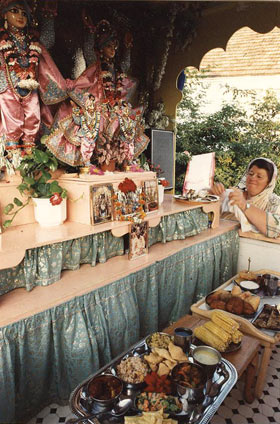 |
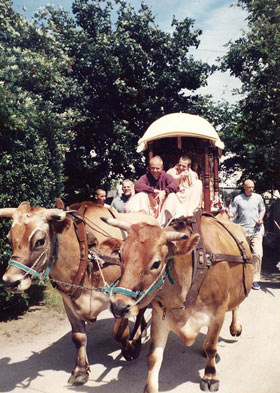 |
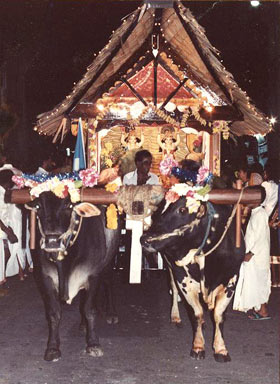 |
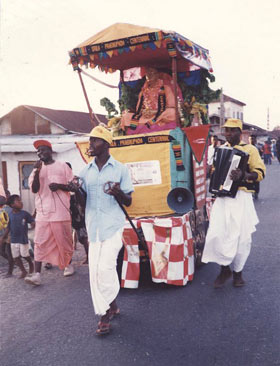 |
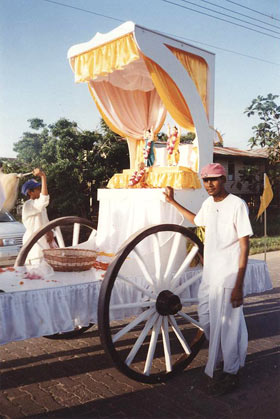 |
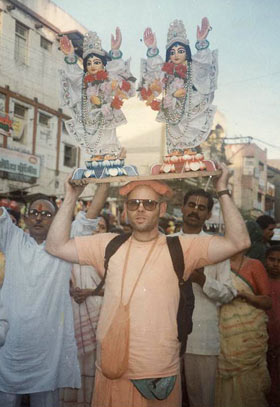 |
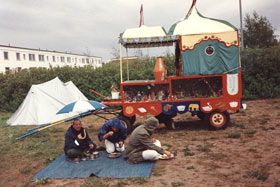 |
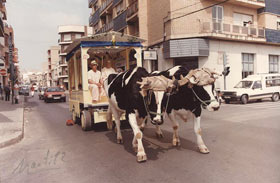 |
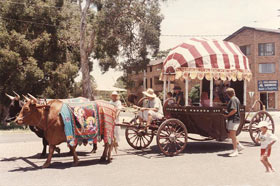 |
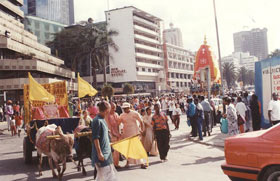 |
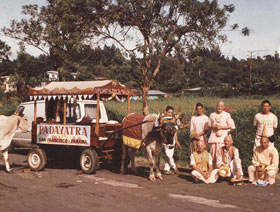 |
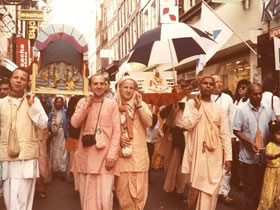 |
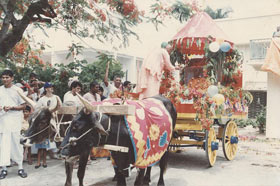 |
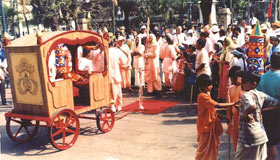 |
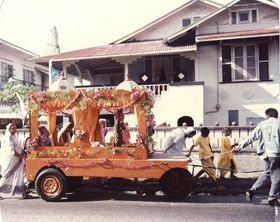 |
c- Four-wheeled cart: design and measurements
8 – INVITE THE DEITIES AND CARE FOR THEM
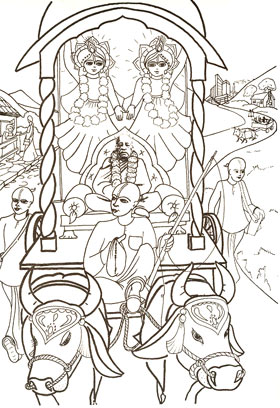 On Padayatra, their Lordships go out Themselves in the form of Sri Sri Nitai Gaurasundara to meet Their parts and parcels, and thousands of conditioned souls get to behold the Padayatra Deities. The more attractively They are dressed and decorated, the more people will be drawn to Them and be spiritually benefited. In India farmers often drop everything to run a few kilometers to catch up with the Deity cart and get a short glimpse of the murtis.
On Padayatra, their Lordships go out Themselves in the form of Sri Sri Nitai Gaurasundara to meet Their parts and parcels, and thousands of conditioned souls get to behold the Padayatra Deities. The more attractively They are dressed and decorated, the more people will be drawn to Them and be spiritually benefited. In India farmers often drop everything to run a few kilometers to catch up with the Deity cart and get a short glimpse of the murtis.
WHICH DEITIES TO INVITE?
1) Sri Sri Gaur Nitai:
Names of Deities:
– Most Padayatra deities worldwide are named “Sri Sri Nitai Gaurasundara”.
– There is no hard and fast rule: Nitai Gauranga, Nitai Sacisuta, etc.
Number of sets:
– Padayatra could have two sets of deities:
– One set of large deities staying on the cart.
– One pair of smaller brass deities for harinams on a palanquin and for home programs.
Material:
– Neem wood is best because of its light weight.
Shape and pause:
– Standing straight or dancing slightly.
– With both arms raised upward.
– With both arms stretched forward.
– One arm raised upward and the other reaching forward.
Deity making:
– Order them in India at least one year in advance.
– Measure the Deities carefully right away, noting the position of the arms also: these measurements will be useful to make patterns for the clothes.
Packing and shipping by plane or cargo:
– Pack them very carefully, in a padded wooden crate, secured with ropes, to make sure they do not move or break during the shipping. Ask for professional tips. Deities have arrived damaged in the past!
Styrofoam is good packing, but detrimental to the environment.
– Get a resine murti.
– Secure it so it does not move.
3) Srimati Tulasi Devi:
– Reserve a place for her on the Deity cart: the presence of Srimati Tulasi Devi will further sanctify the atmosphere.
WHICH PARAPHERNALIA TO GET?
1) Deity outfits:
– Take the measurements as soon as possible, even while the Deities are being made.
– Make a measurement sheet.
– Make various basic patterns: don’t forget to indicate the size and position of the arms and hands so these can fit into the sewed sleeves and tops.
– Have a few gorgeous outfits made in India for the inauguration festival and other festivals.
– Give yourself a good margin of time.
– You could embroider your Padayatra logo on the deity dress or the backdrop.
– Find volunteers to sew outfits: give them the measurements, pattern and color theme.
– Make backdrops
– Measure the space where the backdrops will go.
– Figure out the way they will hang or be secured.
– Make matching backdrops for different outfits.
– Have a basic gold and a silver one.
– Get artistic devotees to paint or sew some backdrops.
– Make tulasi skirts
– Measure the size of the pots.
– Make matching skirts for different outfits.
– Have a basic gold and silver one.
2) Wigs:
– If possible buy wigs for dolls or small heads.
– Consult the expert wig maker in your temple or ask a professional.
– Make your own wigs
– Take a piece of buckrum thick cloth larger than the size of the head to be used as a base.
– Wet it lightly for it to take the shape of the head.
– Cut it to the desired size.
– Secure it in a few places with some stitches.
– Sew the hair taken from a regular wig onto the mold base.
– Trim it on the head of the deity to make it fit well.
– Crowns and effulgences
– Make matching crowns for the outfits made in India.
– Have at least a gold and a silver crown.
– Decorative items
– Turbans, with turban base (soft cloth stuffed with cotton padding)
– Matching cloth fans and effulgences
– Turban pieces
– Measure the space where the curtains will go on the cart (front and sides).
– Decide which hanging system you will use (rods, etc.).
– Get cloth adapted to the environment.
– Rainy countries: waterproof cloth that does not mold.
– Sunny countries: cloth which colors don’t fade in the sun.
– Dark colors might be preferable to light ones.
– They don’t stain so easily.
– Washing curtains on the road is rather inconvenient.
5) Puja and bathing paraphernalia:
– Consult the pujari to make a complete Deity shopping list.
6) Vyasasan for Srila Prabhupada’s murti:
– Make a beautiful vyasasan for the murti of Srila Prabhupada; you might want one
that can be removed from the cart for home programs.
– Prepare a simple cushion for the devotee giving class.
7) Various items:
– Storage containers
– Get plastic storage containers for all the deity paraphernalia and clothes: they will stay dry and occupy less space.
– Make sure they will fit in the different cupboards built into the cart for this purpose.
– Kit to make garlands
– Security device for the murtis
The Deity cart is moving all the time, sometimes on very rough roads, so They need to be secured properly: make a device fixed to the cart that will hold tightly the base of the Deities.
HOW TO CARE FOR THE DEITIES ?
1) The head pujari:
– Coordinates all the aspects of deity worship
– Purchases of supplies
– New outfits
– Schedules: aratis, offerings, etc.
– Training of assistants
– Garlands and decorations
– Deity worship budget
– Security
2) Worship:
– On most Padayatras the Deities receive a simplified form of worship due to considerations of time and place, being on the road, late evening programs and irregular schedules.
– Basic standard of worship
– Three bhoga offerings a day: wake up, breakfast, late lunch or early dinner
– Daily sweets: fancy sweets or fruits, nuts and yogurt
– Night clothes: usually the Deities keep their day outfit on until the next day
3) Security:
– Protect the Deities from possible attacks, as this happened in Muslim countries and Bulgaria.
4) Giving out the mercy:
The pujari is giving mercy to the people in many ways:
– Caranamrita, maha prasadam, maha garlands, etc.
– Opportunities for the people to render service to the Deities
– Offering of prayers
– Giving fruits, flowers, bhoga, clothes, decorations, etc.
9 – GET OXEN AND OTHER ANIMALS
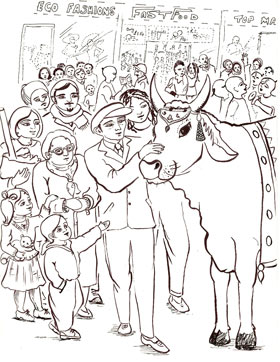 In Western countries the beautiful oxen are stealing the hearts of children and people, especially old folks who had worked with them during their youth, which shows that love for the representatives of dharma is dormant in every soul. In America, once the padayatris started to walk with an oxcart, newspaper reporters came without prior notice. Numerous newspaper articles were written in all cow-killing countries on the importance of cow protection. Most devotees have chosen oxen for preaching purposes, showing that these valuable animals are meant to work and not to be eaten.
In Western countries the beautiful oxen are stealing the hearts of children and people, especially old folks who had worked with them during their youth, which shows that love for the representatives of dharma is dormant in every soul. In America, once the padayatris started to walk with an oxcart, newspaper reporters came without prior notice. Numerous newspaper articles were written in all cow-killing countries on the importance of cow protection. Most devotees have chosen oxen for preaching purposes, showing that these valuable animals are meant to work and not to be eaten.
WHICH ANIMALS TO CHOOSE?
1) Various considerations:
– The country in which your walk takes place:
– List the animals available there: it might be hard to find an elephant in some parts of the world!
– In Latvia devotees had a hard time finding oxen, as bulls were killed when young so that the farmers do not have to feed them during the long winter months. But they were determined and did find some.
– The climate, terrain, roads and topography of your country:
– Mules and donkeys can be useful in mountainous areas with only trails.
– The advantages and disadvantages of different kinds of animals:
– Horses move faster, but are more passionate and less attractive than oxen.
– Oxen are more calm, predictable, and mellow than horses.
– Camels have bad character.
– Elephants are harder to feed and maintain, and they can cause harm to people and damage public or private property. Laksmi, the elephant on Padayatra India, was rather aggressive: once she grabbed a lady and thumped her, walked on her, and the lady almost died.
– Animals that were used in different parts of the world:
– India: oxen, camel, elephant, mules in the Himalayas
– Ireland, Eastern Europe, Central America: horses at times
– Most countries: oxen
– The message you want to put across:
– If you want to preach efficiently on cow protection, the choice is obvious.
– Opportunity to preach about ox power and cow protection
The very presence of the gentle and beautiful oxen provides daily opportunities to inform the public about the benefits of vegetarianism, cow and ox protection.
Cow protection does not mean only protecting the mother, the milking cows. It means also to properly utilize the father, the bull, who becomes an ox when neutered.
– Engaging ISKCON idle oxen
Many ISKCON farms have oxen sitting idly all day getting fat: oxen are happy to work hard. Padayatra gives them engagement and direct service to the Lord by pulling His Deity cart.
– Young bulls also have their place
Baby bulls are so sweet looking but they can be taken for the parade only, not to pull heavy carts, of course. In Canada a team of young oxen was yoked together and walked in front of the Deity palenquin.
– Feeling closer to Krishna
The presence of the oxen reminds us of Krishna and of Goloka Vrindavana. Lord Krishna, as the protector of the cows and oxen, is very happy when His plan for cow protection is put into practice, and the devotees also feel very satisfied.
Appendix a: Ox power (Interview with Sarva Siddhi Ratha das)
WHERE TO GET YOUR ANIMALS?
1) How many do you need?
– It depends on the number of carts you have:
– One or two for each cart
– One or two spare animals so the others can recuperate
2) Where to get them?
– In ISKCON farms
– Buy them
– Borrow them and engage them: most ISKCON farms will be more than happy to let you use their oxen or horses.
– At farmers’ homes in your country
– What to consider when buying animals
– Breed
– Age
– Health
– Training and experience in pulling carts
– Vaccinations and permits required
– Consult padayatris expert in the field: Parasurama Dasa, Jaya Vijaya Das, Balabhadra Das, ISKCON farmers, etc.
HOW TO GET READY FOR THE ROAD?
1) Permits and insurance
Get the required permits for
– Using a bullock or horse cart of the roads
– Transporting animals in the country and across borders
Get an insurance in case of damages caused by the animals
2) Vaccinations:
Inquire months in advance
– The kinds of vaccination you will need
– There could be some quarantines, and delays, if the animals come from a neighbouring country
3) Shoes:
An absolute necessity
– Bulls working in the field do not need to be shoed, but if they walk on roads covered with asphalt, their feet will wear out faster than they grow. They need shoes right from the beginning.
– If the oxen walk without shoes, their hooves will wear down very quickly and they will not be able to pull the cart for at least three weeks until the hoof grows back again.
– Shoeing has to be done regularly, depending on the condition of the road.
– Shoeing differs in the western and eastern countries according to what is available.
– An oxen needs 2 shoes on each foot because his hoof is split, contrary to the horse who requires only one shoe for the whole foot. Thus each bull needs 8 shoes.
Metal shoes
– Most metal shoes last for one month.
– Get them tailored-made for each hoof or buy the standard size shoe.
– Get a good supply of shoes beforehand.
Rubber shoes
– Very easy to use and put on the hooves.
– Very good to protect sore hooves.
– Can be found in specialized stores.
– Easily available in England and New Zealand
– Shoof International Ltd. P.O. Box 522 Cambridge, New Zealand
– You can make your own with rubber tires, as did Saunaka das in the US.
Appendix b: Shoeing oxen the easy way: cattle shoofShoeing
– Padayatris in India developed a simple system for shoeing oxen themvelves, as it was difficult to find nal wallahs; they even got better than them: they purchased professional shoes, good nails and all the necessary equipment in a big city before leaving. It takes time to nail shoes, no point to rush.
– The harness is the “transmission system” of any animal-drawn implement.
– The type of harness used greatly affects the amount of useful power generated.
– Always keep a spare one in case one breaks.
Appendix c: Major types of harnessing
5) Decorations:
Bullock covers
– They add a festive finishing touch to the parade.
– Use materials that can be easily washed as they get dirty quickly:
– Cotton and velvets
– Avoid metal trimmings that are harder to get clean.
– Have them made in India: they are still being used during festivals.
– Do it yourself:
– Cut a rectangular piece of cloth to the size of the animal.
РAdd embroideries, appliqu̩s, trims, etc.
– Sew a ribbon or a piece of cloth to tie it under the animal’s belly.
Horn decorations
– Paint the horns with bright colors.
– Add colorful balls to the tips of the horns, a decoration and a safety device.
Forehead shield
– Cut a triangular shape and decorate it.
– Tie it to the horns on both sides.
Bells and necklaces
6) Miscelleneous items:
– Brush to clean the animals.
– Buckets for oats and water (large enough for their heads).
– Ropes to tie the animals with.
– Hay storage container: on Padayatra India one trolley was used for storing the oxen’s food and their buckets.
– A tarp to provide shelter in the rain or protection from the sun.
– A broom and a shovel to clean up after them: even though cow dung is pure and holy, your average city dweller will not appreciate his street or sidewalk being polluted.
HOW TO TRAIN YOUR OXEN?
– Animals should be young and healthy: Padayatra is very demanding.
– Ideally the trainer should have worked with oxen for at least 2 years before taking full responsibility of the animals on the roads.
– It is better that the person who trained the oxen is the one who will be with them during the walk.
– Take the time to train the oxen properly: it takes at least 2 months for the animals to learn how to pull a heavy cart and respond to a command.
– The oxen will have to walk on the busy roads and not panic in heavy traffic or amidst a noisy crowd. This is a question of security.
Appendix:
d- Contents of the “Ox training handbookâ€, by Balabhadra das, and “Ox Power Ki Jaya!†by Paramananda das (ISCOWP web page).
e- Contents of the “Ox power handbookâ€, by Parasuram das.
HOW TO CARE FOR OXEN?
1) The caretakers:
– Best to have the same devotee rendering this service during the entire walk.
– He/she can train a few assistants for various tasks.
– The caretaker should be properly trained himself/herself.
2) Diet:
 Main diet: plenty of oats and fresh grass. Oxen like the same food all the time
– India: rice grass, millet (bhadra and juri grass), corn grass, dahl skin, green corn grass
– Special treats: roughage, bread
– Don’t let the animals eat grass alongside the road: they will get into a habit and do it
when they are supposed to pull the cart.
– No spontaneous eating in the neighbour’s field: tie the animals.
– If you get an oxen from a distant place, consider the diet he is used to already. In India, if you take a bull from Maharashtra and give him other food, he will die. The sturdy Konkrj breed from Gujarat are an exception. With their big towering horns, they are very strong compared with other Indian bullocks, and can tolerate changes in food and climate.
– Diet and treatment for the Konkrj oxen in India:
– Before or just after mangal-arati: first grass of the day.
– Rest for a while.
– Water.
– Toilet with a brush.
– Morning walk till around 9 am.
– Eat some grass then relax for a while before getting hiched up again.
– Drink before and after the walk of the day.
– Arrival at camp around 4 pm.
– Main meal: mixture of fruit and wheat bran, bran and dahl skins and oil cake.
– Evening: grass again.
3) Health tips and diseases:
– Consult specialists and specialized books.
4) Shelter and protection:
– Wherever the animals stay at night, someone must stay with them:
– They might get stolen in poor countries (it happened several times!)
– Find a field, a farm or some public land in a city (with prior permission)
– Plan in advance what you will do with the oxen when they get old, sick, or when the walk is finished.
5) Transportation:
– Use a proper animal trailer so the animals are comfortable:
– Rent a trailer.
– Have your own trailer handy if you often need to skip long stretches of road.
– Inquire about permits, as in some countries there are strict regulations concerning animal transportation.
6) Security on the road:
– The cart driver should know how to drive safely and handle the animals on the road: the animals can get scared in heavy and noisy traffic.
– Drivers have to be careful: Padayatra will be held responsible for damages caused to pedestrians, motorists, vehicles or private property.
7) Retirement and departure:
– Some oxen have served on Padayatra India up to seven years, and they deserved a peaceful place to end their lives. Padayatra leaders sent the old and tired oxen to ISKCON farms to retire and quit their bodies surrounded by the holy names and caring devotees.
– The four-legged padayatris who have served the Lord faithfully for many years are honoured with a special ceremony when they depart from this world.
8) ISKCON cow protection standards:
-Standard 7 Travelling and Preaching Programs of the Minimum Cow Protection Standards are part of the ISKCON law 507. It was composed by cowherds internationally.
The standards can be downloaded at http://www.iscowp.com.
APPENDIX
Articles
a- Ox power: interview with Sarva Siddhi Ratha das, head of the Ox Development program at the Murari Sevak farm community in Tennessee – part 1 | part 2
Shoeing oxen
b- Shoeing oxen the easy way: cattle shoof – part 1 | part 3 | part 4 | part 5 | part 6
Harnesses and yokes
c- Major types of harnessing
ISCOWP web page
d- Contents of the “Ox training handbookâ€, by Balabhadra das, and “Ox Power Ki Jaya!†by Paramananda das.
Book
e- Contents of the “Ox power handbookâ€, by Parasuram das.
10 – USING MOTOR VEHICLES
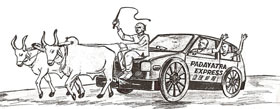 Most Padayatras use motor vehicles in one way or another. Vehicles are used in a direct way to assist the walkers, for the advance party, to transport devotees, books, animals or festival items, and as a mobile kitchen. Or in an indirect way, by taking a train, a boat or a plane to carry the Padayatra from one location to another, as in Siberia, Australia and the Carribean islands. In all cases, utility is the principle. Devotees are ready to use whatever commodities are available to facilitate the preaching. It is best to keep them to a minimum, though, in order to present our motto of simple living and high thinking. When the devotees were preaching in India with two huge Mercedes buses, Srila Prabhupada instructed them to adopt Vedic bulls instead of modern machines.
Most Padayatras use motor vehicles in one way or another. Vehicles are used in a direct way to assist the walkers, for the advance party, to transport devotees, books, animals or festival items, and as a mobile kitchen. Or in an indirect way, by taking a train, a boat or a plane to carry the Padayatra from one location to another, as in Siberia, Australia and the Carribean islands. In all cases, utility is the principle. Devotees are ready to use whatever commodities are available to facilitate the preaching. It is best to keep them to a minimum, though, in order to present our motto of simple living and high thinking. When the devotees were preaching in India with two huge Mercedes buses, Srila Prabhupada instructed them to adopt Vedic bulls instead of modern machines.
UTILITY IS THE PRINCIPLE
The style of your Padayatra, the number of devotees walking and the length of time on the road will determine which and how many vehicles you will need. One vehicle may serve many functions.
1) Cars for advance party work:
– One car is sufficient for a fairly simple Padayatra.
2) Vehicle for transport of devotees, errands and luggage:
– Get a big enough vehicle (bus or van) for these different functions:
– Purchasing bhoga and supplies.
– Transporting the devotees’ luggage.
– Transporting devotees to a festival, a home program, etc.
– Carrying tents and festival equipment.
– Carrying all the kitchen equipment, water and gas tanks.
3) Vehicles for book distribution:
– Vehicles allow padayatris to reach areas and villages where the walking party does not go through. They are a necessity in unpopulated areas.
– Various options:
– Sankirtana van or car
It can be used also as a book storage.
– Motorcycles
Padayatra India has recently been using a couple of motorcycles with great success.
– A separate motor vehicle.
– A trailer hauled by a car or van–make sure the car towing it is powerful enough.
– Get the right permit and insurance.
5) Food For Life vehicle:
– If the temple or yatra has a Food for Life vehicle, bring it. It was a great asset in Australia.
6) Vehicle to accompany the walk:
– Very practical for a large party with many children and no separate children’s cart.
– Used to carry young children and tired walkers, book distributors lagging behind, refreshments, snacks, coats and umbrellas, etc.
7) Animal trailer:
– An animal trailer is a must for transporting oxen and other four legged padayatris.
– It will allow you to take them to a festival site or the next destination, get new animals and relocate the old or tired ones.
– It is best to rent it if you need it only occasionally, but it is rather costly. Borrowing one is the next best choice, and buy one if you need it often.
– It can replace a few of the smaller vehicles and use it for books, devotees, luggage, kitchen equipment, etc.
– It can be used as a travelling temple when there is no bullock cart, or in addition to it: Padayatra America had a bus for a couple of years, which allowed devotees to go to home programs, festivals, etc.
9) Vehicle or cart for storing hay:
– You might need a separate vehicle for storing feed and hay for the animals, and hay is not easily available along the route.
PRACTICAL CONSIDERATIONS
1) Buying, renting or borrowing:
– Buying new or used: check the various options and prices available and get the help of people who know something about vehicles.
– Renting: put rented vehicles in the hands of good drivers only, or Padayatra will have to pay for damages done to the vehicle.
– Borrowing: clarify with the owner who will pay the maintenance and repairs and what will happen in case of accident or major technical breakdown. Make sure the drivers are insured.
2) Maintenance and repairs:
– Allot a budget for maintenance and repairs.
– Make sure the vehicles are checked by a mechanic before the walk.
– Have regular check ups on all vehicles: oil, water, tires, brakes, without forgetting gas.
– A qualified mechanic is a great asset on Padayatra, especially on long walks and bad roads.
– Carry spare tires and basic tools.
3) Drivers and legalities:
– Too many different drivers can ruin a vehicle: stick to a few qualified drivers.
– Take care of legalities: insurances, valid drivers licence, driving in other countries.
4) Signs and decorations:
– Paint or post signs and decorations on your vehicles, especially the large ones – it is preaching and free advertising:
– Ex: “Padayatra America”, “On the road from Belfast to Moscow”, maha –mantra, etc.
– Map of the country with the Padayatra route.
– Lord Caitanya and His devotees chanting and dancing, etc.
– Advertise the Padayatra theme and festivals.
5) Think about parking:
– Notify the advance party to find legal places to park all these vehicles, close to the Padayatra camp or festival site.
– Knowing the measurements – height and width – will make it easier for them.
11 – DO ADVANCE PARTY WORK
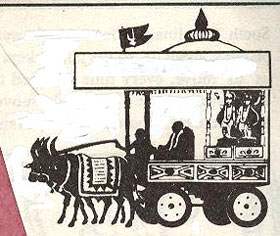 The advance party is at the very heart of the Padayatra organization. It drives ahead and choses the route, chalking out the destiny of the devotees who walk behind into ecstasy or confusion. Depending on the size of your party, your level of spontaneity and your manpower available, advance party work can be done months and weeks in advance, a few days ahead of the walk, and in extreme situation the very same day, a few hours ahead. The sooner the better, of course, especially if you want to stage big functions which require dates to be fixed in advance. In India the padayatris met anotherf walking party that had all its arrangements completely fixed a whole year in advance.
The advance party is at the very heart of the Padayatra organization. It drives ahead and choses the route, chalking out the destiny of the devotees who walk behind into ecstasy or confusion. Depending on the size of your party, your level of spontaneity and your manpower available, advance party work can be done months and weeks in advance, a few days ahead of the walk, and in extreme situation the very same day, a few hours ahead. The sooner the better, of course, especially if you want to stage big functions which require dates to be fixed in advance. In India the padayatris met anotherf walking party that had all its arrangements completely fixed a whole year in advance.
FUNCTIONS OF THE ADVANCE PARTY
1) Get ready before driving the route:
Equip yourself with the necessary information:
– Recent and detailed maps.
– Presentation folder for advance party.
– Padayatra pamphlets.
– Press kits.
– Letters of recommendation.
– Recent newspaper clippings with favourable reviews.
– Pens and notebooks.
– List of devotees and life members living in the area of the walk.
– Addresses and phone numbers of people Padayatra would like to meet: religious leaders, press people, various officials and other contacts
2) Check out the entire route:
Drive the entire route:
– Draw the planned itinerary on the map, calculating the daily walks.
– Try to make a fixed schedule as soon as possible: you will be able to plan all your big festivals and be there without anxiety.
– Check out for obstacles (low overhead bridges, tunnels, roadwork, etc.), observe the topography (steep hills, etc.) and make a note of them.
– Inquire about public events (bicycle races, demonstrations, etc.) that could interfere with a smooth parade on the route.
Walk the entire itinerary of the parade in town:
– Look for malls, squares, parks and open spaces where you can:
– Stay for a while to have harinam
– Stage displays and exhibits
– Distribute prasadam from your Food for Life table, van or truck
3) Meet Town and City Councils and other officials and get permits:
– Inquire from officials which streets are meant for walkers and parades.
– List the permits that will be required: carts, oxen, animal transports and vaccinations.
– Get the permits.
– Make arrangements for the mayor and other officials to meet the walking party, participate in the parade, cut the inaugural ribbon, garland the footprints of Lord Caitanya, make a speech, etc.
– Inquire about special events that will take place on the road or in the area at the time Padayatra will be in the area.
4) Contact the press and radio:
– Do it if this is not done by the communication team.
– Make a list of all the media (radios, newspapers, TV) in the areas you will walk.
– Visit all the media, reporters, newspapers with a news package.
– Give exact day, time and location when Padayatra will be in town.
– Give the name and phone numbers (fixed and mobile) of the Communication representative.
5) Inform people of Padayatra’s arrival and festivals:
– Pay a visit to local priests, nuns, monks, mullahs, etc. for interfaith encounters.
– Locate community notice boards in towns and put posters and invitations on them.
– Inquire about free advertising for non-profit organization’s events in newspapers and radio stations.
– Put up posters advertising the arrival of Padayatra and the coming festivals.
6) Look for accommodations:
– Try to accommodate the devotees in one place or close locations: school, camp ground, church, monastery, temple, farmer’s field, football field, daramashalla, nama hatta members’s house, motel Patel, community hall, etc.
– Keep in mind the separation of men and women.
– Try to put all the parents with children in a separate room or tent.
– Locate a water source for cooking, bathing and laundry: taps, wells, pumps, tanks, etc.
– Inquire about clean rivers, lakes and ponds for bathing.
– Locate spots to park the cart(s) and the vehicles.
7) Don’t forget the four-legged padayatris:
– Find overnight resting places for oxen, horses, and other animals.
– It is best to locate a fenced area where the bulls can graze and relax.
– Possibilities to be checked: showgrounds, stockyards, farmers, race courses, campings, etc.
– In case you cannot find a suitable place in town, look for one close to the city, and select a couple of devotees to stay ovenight with the animals, for security purposes. Horses have been stolen in a few Padayatras.
8) Investigate places for visits, evening programs, or Padayatra festivals:
– Inquire about public events in which Padayatra could participate: carnivals, parades, concerts, festivals, other pilgrimages, walks, chanting and prayer vigils, peace walks, etc.
– Investigate places to hold your programs:
– Devotees living in the area
– Homes of Nama Hatta members
– Schools
– Old people’s homes
– Rotary clubs
– Hindu and other temples
– Camp grounds
– Lepers’ colonies (ex: Guyana)
– Prisons, for prasadam distribution (ex: Surinam)
– Investigate places to hold festivals: community halls, parks, schools, temples, or a central place to put your own pandal tent.
– Work out with the hosts the details for home program:
– Decide who will cook what, in which quantity, and who will pay.
– Check with hosts if they need your pots and stoves.
– Put up posters announcing the walk and festivals shortly before the Padayatra arrives.
SERVICES DURING THE WALK
1) Be reachable, get a mobile phone:
– Mobile phones were made for padayatris: use them to communicate with the nearby temples or the Padayatra office to solve problems, coordinate action, assist devotees willing to join the walk or call the police or the ambulance in emergency cases.
2) Reconfirm by phone or in person the previous arrangements that were made:
– Check out if the situation is still the same as the one you announced previously to your hosts, the press or officials: number of walkers, number of carts, animals, vehicles, etc. duration of your stay in one location, etc.
– Make final arrangements: timing, location, kitchen utensils available, helpers in kitchen, musical instruments, etc.
– Decide who will be cooking, the padayatris or/and the hosts and who will pay for the ingredients or contribute specific ones.
3) Inform the walkers of the route and accommodations:
– Post on the Padayatra notice board the exact itinerary, the address and location of the accommodations and of the festivals, as book distributors and slow walkers tend to lag behind and get lost.
4) Carry with you all the permits:
– Always carry all the permits with you and the letters of invitation.
5) Recontact the media:
– Do it if there is no special communication team.
– Give exact times and location of where Padayatra will be in town so the press can meet the procession, do interviews, take photos, etc.
12 – FIND ACCOMMODATIONS
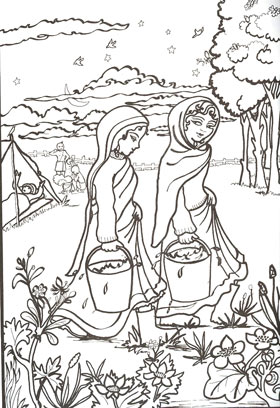 One advantage on padayatra is that devotees cannot get attached to any residence, not even their tent or their little corner. They learn how to depend on Krishna, knowing that He is the supreme controller and that He will provide something suitable to His servants who are usually too tired or blissed out after the walk to really care. Tomorrow will be another day….
One advantage on padayatra is that devotees cannot get attached to any residence, not even their tent or their little corner. They learn how to depend on Krishna, knowing that He is the supreme controller and that He will provide something suitable to His servants who are usually too tired or blissed out after the walk to really care. Tomorrow will be another day….
LOOK FOR ACCOMMODATIONS IN ADVANCE
It is the responsibility of the advanced party:
– To check various possibilities and make contacts, if necessary reservations, a few months in advance.
– To contact the potential hosts for reconfirmation shortly before the walk arrives.
– To go a couple of days before the walkers arrive to make all the proper and final arrangements.
INVESTIGATE VARIOUS POSSIBILITIES
1) ISKCON temples and nama hatha centers:
– Stay for a few days in one place and walk through different parts of the same town.
2) Homes of congregational members:
– Make sure the devotees do not get scattered all over town. Some could stay in the homes of congregational members while others could camp nearby.
3) Friendly people’s homes, gardens and backyards:
– Padayatris have been accommodated in the most unlikely places by the least expected kinds of persons.
4) Monasteries and churches:
– They proved to be wonderful accommodations in many countries.
– The situation creates ideal opportunities for interfaith encounters .
– Ask the priest if the devotees can hold mangal arati and have kirtans in the church, chapel or even the mosque!
5) Schools and festival halls:
– Usually comfortable halls with all facilities: space, bathrooms, stage, etc.
– If there is only a large single room, arrange separate men’s and ladies’ quarters with thick sheets and cloth.
6) Hotels and motels:
– In many countries, Indians own hotels and are more than happy to host the entire Padayatra party for free: in California padayatris were welcomed royally in “Motel Patelâ€, motels owned and managed by pious Gujaratis.
7) Padayatra vehicles:
– A few devotees can sleep in their vehicles: bus, van, campers.
8) Camping out:
– Camp on farmers’ fields, public land or camping grounds.
– Make arrangements or reservations in advance, especially if you have a large party.
– Don’t forget to mention all the animals, to avoid bad surprises.
9) Unusual facilities:
– Bullrings: in the south of France, when local officials were short of facilities, they would let the devotees stay in the town’s bullring, which is always close to the cemetery by the way…
SET UP CAMP AND ORGANISE IT IN A VAISNAVA WAY
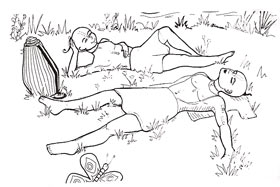 1) Logistics to be considered:
1) Logistics to be considered:
Several options are available:
– You set up camp on the spot where the daily walks ends.
– You transport the devotees to distant accommodations and leave the ox cart and the animals behind where the walk ended for the day.
2) Components of the camp:
– Separate accommodations for men and women
– If this is not possible at least keep some distance between them.
– Tents
– Get enough tents for everybody to be comfortable.
– Accommodate devotees with small or noisy children in a separate tent.
– Water sources
– Use local taps, tanks and wells.
– Use a water tank trailer when there is no other water source: fill it up from fire hydrants or get it from fire departments.
– Camp near a lake or a river: devotees can bathe, do their laundry and swim in it
– Shower stalls
– When there are insufficient or no bathing facilities, make up your own shower stalls or buy ones.
– Make sure these are set up before the tired walkers arrive at the camp.
– Toilets
– In the cities, rent portable toilets, especially during festivals.
– In the country, avoid turning the nearby fields into a stool ground: install a tarp around a hole dug in the ground. Don’t forget to cover it entirely with earth when the party leaves.
– Kitchen corner or vehicle
– Install the kitchen near water and electricity sources.
– Campfires
– A pleasure not to be missed in cold countries.
– Ask for permission ahead of time: fires are strictly prohibited in certain areas or during certain times of the year, as they are a fire hazard. You could get a heavy fine for breaking the law.
– Get dry wood, kindling and newspapers in advance for the next day.
– Deity cart
– Keep reasonable distances with habitations so neighbours will not be disturbed by the early morning or late evening kirtan.
– Park the cart in a spot with enough room around it if the programs take place outside.
– Vehicles
– Find parking spots for all the vehicles near your accommodations.
– Plan carefully if you have large size vehicles.
– Animals
– Find a field or grassy area for the animals.
– Tie them securely with a rope so they don’t run off to eat the neighbour’s lawn or cornfield.
– Security
– Always have a fire extinguisher at hand near the kitchen.
– Don’t leave the camp unguarded with valuables in tents or unlocked vehicles.
– Have a First Aid kit ready.
– Cleanliness
– Bring what you need: trash cans, plastic bags, brooms, cleaning supplies, etc.
– Set up trash cans and dispose of garbage and dirty water properly.
– Always leave the place cleaner than you found it: it is brahminical!
– Other considerations
– If you break something belonging to your host, just replace or fix it.
– Set laundry lines in a discreet spot.
– Environmental considerations
– Use Bio degradable soap or earth for cleaning cooking utensils, as it is done in India.
– Renounce srtyrofoam, plastic plates and cups, which are a nuisance for Mother Earth: use the paper ones that can be burned, and ask devotees to bring their own. If plates made from leaves are available, use these.
– Manage waste responsibly: recycle!
– Take the items that can be recycled to the nearest recycling center or containers.
– If there are none closeby, store the clean bottles and containers in a Padayatra vehicle until you can properly dispose of your waste: do not dump your refuse just anywhere!
– In the kitchen and in the camp, designate different bins for different items and dispose of these differently:
– Paper and carboard: burn them.
– Glass bottles and containers: recycle.
– Plastic boxes, containers and bottles: recycle.
– Organic waste: Give what is edible to the animals.Give the waste to someone who has a compost in their garden.
Throw the rest in a discreet place.
APPENDIX
– Article by H.H. Mukunda Goswami about environmental concerns: “People want to know: Do we care?†(ISKCON Communications Briefings July/Aug 1991)
“People want to know: Do we really care for the environment ?â€
H.H. Mukunda Goswami (ISKCON Communications Briefings July/Aug 1991)
“On May 4, the North American GBC banned styrofoam from use in temples along with non-biodegradable detergents and soaps. The resolution also directs each temple to use recycled paper wherever possible and to take up recycling programs in the disposal of garbage. Note: IWR, BTG, and ICB now state in each issue that they are printed on recycled paper.
This resolution (voted by the North American GBC and temple presidents), although jurisdictional only in North America (and enforceable maybe nowhere), is almost revolutionary for ISKCON. Rarely does the GBC attempt policies with this powerful an impact on temples’ economic independence.
The exceptional move signals a sensitivity on the part of ISKCON leadership to public concerns about the environment.
Environmental quality has become the most important single worldwide issue of the day, and public opinion experts say this will continue, probably through the remainder of the decade.
If ISKCON follows this GBC resolution, this will help demonstrate to a public generally ignorant of Krishna consciousness that devotees care about the quality of life on our planet, a fact generally unknown to the public.
Okay, you might say, but we have a pamphlet on the environment, and we’re putting a book out about our perspective on the environment and our philosophy is that Krishna consciousness in and of itself is the highest welfare work. Why endeavour extraneously, worrying about garbage disposal, styrofoam, and recycled paper?
Just after the recent lecture in the New York temple by Romapada Swami, a guest challengingly asked why the temple used cups and plates made of styrofoam, whose manufacture is widely thought to erode the earth’s ozone layer and add to non-biodegradable waste.
After explaining that it was probably because styrofoam costs less, the guest volunteered to help find inexpensive alternatives to styrofoam. Romapada Maharaja feels that the implementation of certain environmentally conscious habits is a great and important challenge for ISKCON. He fears that after publishing a book on the environment we might be regarded as hypocrites if we don’t clean up our environmental act.
It’s essential to provide the philosophical basis for creating a purer world, but, as Srila Prabhupada said many times, “practice is better than precept.â€
Part of an excellent communications program these days is the capability to make appropriate changes in our personal and collective behaviour to meet current preaching needs. Instead of contradicting or compromising our Vaisnava principles, appropriate changes will support them.
A commitment to renounce styrofoam, use recycled paper, and manage waste responsibly would be a great place to start.
13 – MANAGE THE KITCHEN AND DISTRIBUTE PRASADAM
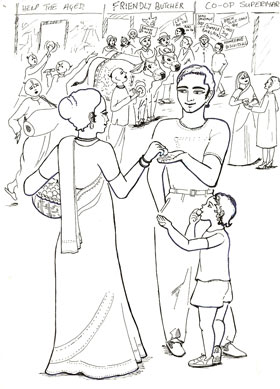 We all know that an army runs on its belly, and the success of Padayatra will be largely determined by the satisfaction of the devotees in regards to prasadam. Besides feeding the transcendental army, Padayatra is a great opportunity to distribute prasadam on a grand scale and purify so many people. Srila Prabhupada insisted so much on the distribution of Bhagavat prasadam. Every Padayatra has distributed some kind of prasadam, whether in a humble or spectacular way. Large-scale distribution means a dedicated crew of devotees to collect the ingredients and organise the cooking and serving, which takes determination, ability and stamina. People are eager to help, charitable men are ready to give staples and money. It just takes organized efforts and planning on the organizers’ side.
We all know that an army runs on its belly, and the success of Padayatra will be largely determined by the satisfaction of the devotees in regards to prasadam. Besides feeding the transcendental army, Padayatra is a great opportunity to distribute prasadam on a grand scale and purify so many people. Srila Prabhupada insisted so much on the distribution of Bhagavat prasadam. Every Padayatra has distributed some kind of prasadam, whether in a humble or spectacular way. Large-scale distribution means a dedicated crew of devotees to collect the ingredients and organise the cooking and serving, which takes determination, ability and stamina. People are eager to help, charitable men are ready to give staples and money. It just takes organized efforts and planning on the organizers’ side.
ORGANISE THE KITCHEN DEPARTMENT
1) Any kitchen will do:
– Types of kitchens: clean space in the grass, tent, trailer,van, mobile home, your guest’s kitchen, or the kitchen of your residence (school, motel, festival hall, etc).
– Devotees will be cooking for the Deities, the devotees and the public.
– Always set up the kitchen near a water source: water tap, pump, well, river, etc.
– Make sure the area is fire proof and will not endanger the surrounding land or property.
– Have a fire extinguisher at hand.
– Keep it clean and tidy:
– Set up trash cans.
– Have cleaning supplies at hand.
– Recycle all bottles, boxes and jars (glass, plastic, cardboard) in the recycling containers provided by cities and towns. (More details in section 12- Accommodations)
2)The cooks:
– The head cook
Get a good cook who has experience cooking in large quantities and managing a kitchen:
– Make menus.
– Make shopping lists.
– List the equipment required.
– Train assistants.
– Assistants may vary from day to day or be more permanent: it’s up to you.
– Vegetables can be cut during class to save time.
3) Kitchen equipment:
– Pots and pans
– Gas stoves and ovens
– Serving pots and containers
– Storage containers
– Serving utensils, knifes, etc.
– Towels, aprons, cleaning utensils
– Plates, cups and spoons for guests and Food for Life programme: renounce styrofoam and plastic cups and plates.
– Invite devotees on the walk to bring their own cups and plates.
– In Sweden Jayadeva das brought a large army woodstove.
4) Bhoga:
– Dry items: flour, oil, spices, grains, etc.
Buy them wholesale.
– Put them in tight containers.
– Fruits and vegetables
Get them from local farmers and markets.
– Get it donated
Devotees and members owning stores.
During the walk: door to door, markets, farmers, etc.
Encourage devotees and congregation members to donate or sponsor entire meals.
KNOW WHO YOU WILL BE COOKING FOR
1) The Padayatra Deities:
– Padayatra Deities have roughly the same menu as padayatris.
– Make easy-to-make morning sweets.
– Have at least one consistent offering in the middle of the day: the raja bhoga.
2) The devotees:
– Devotees walk and work hard all day long: make sure they all get plenty of healthy, tasty prasadam at the right times: when they are hungry, and when they need the energy !
– Schedules and menus should be adapted to the time (weather), place (desert or lush countryside) and circumstances (what’s available and your budget), and especially to the people.
– Meals
Substantial breakfast
Right after class
Cereals, milk and fruits
Kicchri with plenty of vegetables, etc.Snack
Necessary if main meal is served late afternoon
A must for all children on the walkMain meal
Try to serve it no later than 4pm
Late prasadam means less mangal arati attendanceHot milk at night with a light snack
3) Food for Life:
Benefits
– It is said in the Vedic Scriptures that any sacrifice performed without distribution of prasadam is considered to be in the mode of ignorance.
– Mass distribution of free food establishes us as a benevolent organisation in the eyes of the public.
– In poor villages and places with draught and shortages, a Krishna conscious discourse mean less to the people than a plate of tasty prasadam.
Srila Prabhupada’s desire
– Srila Prabhupada started the “Food for Life” programme to benefit the needy. He instructed his followers that no one within ten miles of ISKCON temples should go hungry. Srila Prabhupada said that those who eat prasadam are sure to become devotees of the Lord.
Various kinds of prasadam to distribute during the walk
– Caranamrita
– Candy
– Peanuts
– Cookies
– Coconut balls
– Simply wonderful
– Popcorn
– Bananas
– Sweet rice
– Halavah
– Kicchri
– Fruits in season
Serving prasadam
– In western countries, put the prasadam in small packets or on small paper plates, especially if it is a little sticky. People are not used to eat with their fingers.
Meals during festivals
– Serve a complete feast: poppers or puris, subjis, rice, sweets and drink, etc.
Get help for funds, bhoga and manpower:
– From the local “Food for Life” program.
– From the devotees, the hosts and the congregation.
– Beg from farmers, producers, businessmen, merchants, wholesale grocers, etc.
– Approach charitable men and institutions for donations.
14 – ORGANIZE FESTIVALS
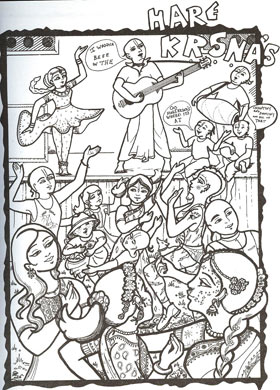 Despite the fact thatPadayatra is already a walking festival, other festivals can be organized in addition to the usual parade to enhance the overall preaching efforts. Walkers can also join festivities organized by other groups, which has proved to be a real winner in UK, under the leadership of Parasuram das.
Despite the fact thatPadayatra is already a walking festival, other festivals can be organized in addition to the usual parade to enhance the overall preaching efforts. Walkers can also join festivities organized by other groups, which has proved to be a real winner in UK, under the leadership of Parasuram das.
VARIETIES OF FESTIVALS
1) Different organizers:
– Festivals are one of the highlights of Padayatra: they are great preaching opportunities and can generate much needed laksmi.
– Padayatra organizers may want to arrange their route and schedule in order to
participate in devotee festivals or other festivals in the area, thus saving valuable time and energy.
In England, Parasuram das brought his Padayatra party to many public festivals and parades,
and won many prizes for his colourful crew and decorated cart.
2) Variety of festivals:
– Padayatra festival and parade.
– Special inaugural and closing festivals.
– Festivals at ISKCON temples.
– Festival at Hindu temples and other temples or churches.
– Participation in other religious festivals: Kumbha Mela and Dindi Yatra in India.
– Padayatra teaming up with Ratha Yatra.
– Maha harinams in large cities: invite all the devotees in the area.
– Public festivals, fairs and parades.
3) Festival program:
The possibilities are unlimited:
– Chanting and dancing
– Ox cart parade with decorated oxen and cart
– Indian dances
– Dramas and puppet shows
– Bhajans and kirtans
– Lectures
– Question and answer booth
– Multi media show
– Displays, dioramas, exhibits
– Book tables
– Mini store:sale of devotional paraphernalia and indian crafts.
– Children’s corner: face painting, coloring contest.
– Prasadam distribution: free feast, goods for sale.
– Special instant photograph of a member of the public with the cart, the oxen, or displayed as a devotee!
4) Inaugural festival:
Where to hold it?
– In an ISKCON temple.
– During a Vaisnava festival (Ratha Yatra, Gaur Purnima, Sankirtana festival, etc.)
– During a legal holiday or a festival organised by non-devotees.
– In a border town, if Padayatra is going through different countries.
Who to invite?
– Local GBCs, sannyasis, renounced vaisnavis, devotees, congregational members, gurukulis, everybody!
– VIPs: mayor, council members, etc.
– Personalities favorable to Krishna Consciousness.
– Heads of different religious organisations in the area.
– Animal rights activists, especially if you are using oxen.
How to celebrate?
– Deity installation: Sri Sri Nitai Gaurasundara and Srila Prabhupada’s murti:
It is the highlight of the festival.
Make a new gorgeous outfit.
Gather auspicious items: tulasi, kumari girls, a calf, abhiseka ingredients.
– Coconut breaking ceremony in front of the cart:
It is a tradition in India and creates auspiciousness.
– Visit to Srila Prabhupada’s pastimes sites
Invite devotees who were present at the time Srila Prabhupada visited these particular places: they can recall wonderful pastimes.
Read from the various Lilamritas and Prabhupada’s biographies.
– Padayatra parade in town
Go on procession with the bullock cart, the deities and all the devotees.
Make it festive: have children wear various costumes.
– Fund-raising
Best time to do it, as the spirits and the level of enthusiasm are high.
Experience has proved fund-raising to be very successful during that time.
– Getting commitments
Get devotees to commit themselves to services, time on the walk, cooking, holding home programs, sponsoring books, etc.
5) Closing festivities:
– Grand welcome to the padayatris
– Invite devotees, congregation, friends, media, officials, etc.: they could walk with the Padayatra party for the last few kilometers.
– In India, when the Padayatra party arrived in Mayapur they were received by thousands of devotees, gurukula children chanting vedic mantras and even Gulab, the Mayapur elephant.
– Go-puja to the four legged padayatris
– The Bhaktivedanta Manor in England performed a wonderful go-puja ceremony to all the oxen that pulled the Padayatra cart in UK for months.
– Huge feast for the Padayatra deities
– Also in the Bhaktivedanta Manor devotees celebrated the arrival of padayatris with a festival during which 108 preparations were offered to Sri Sri Nitai Gaurasundara.
– Plays, mimes and songs about the Padayatra adventure
– In England devotees composed a nice and funny Padayatra song that they also mimed.
– Thank you and realization session
– Padayatra leaders give plenty of thanks to all those who rendered service and participated to the success of the walk, even in a small way.
– Padayatris share their realisations and adventures.
– The managing team makes an evaluation of what has been accomplished, what worked, what were the difficulties encountered and how they were faced.
– All the scores are announced: books and prasadam distributed, number of newspaper articles printed, TV and radio shows that took place, mayors that participated, etc.
– Plans for the future
Do not stop there:
– Make Padayatra a yearly event.
– Continue to the next state, country, etc.
– Try a new style of Padayatra.
– Padayatra souvenir issue
– The last Padayatra newsletter can turn into a souvenir issue including photos, scores, realisations, poems, stories, etc.
PREPARATIONS AND ORGANIZATION
1) Practical items:
– Stage and curtains
– Festival tent or pandal
– Light and sound system
– Decorations
– Bhoga for the feast
– Plates and cups for the guests
– Books and paraphernalia for sale
2) Specific preparations:
– Parade through town: route, timings, cleaning after animals.
– Dramas and puppet shows: texts, costumes, setting, accessories, make up, etc.
– Lecturer with a lecture relevant to the specific audience.
– Donations boxes in addition to the ones on the cart.
3) Exhibits and displays:
In 1984, Padayatra India had 16 dioramas of Caitanya and Krishna lila, and a huge pandal tent with photo displays, which attracted millions of people.
Practical considerations
– Make them with light material.
– They should be easy to handle, fold and store.
– Laminate the texts and photos for protection from dirt, dust and rain.
– Build a device to hold, support or hang them.
– Devise a system so the text can be easily removed (for different languages).
Display themes
– Local Padayatra (photos, clippings, map, routes, etc.)
– Padayatra Worldwide.
– Cow protection and ox power.
– Vegetarianism.
– Reincarnation.
– Local ISKCON activities.
– Srila Prabhupada, his books and achievements.
Dioramas
– Reincarnation, Krishna and Caitanya lila, stories from the Bhagavatam, etc.
4) Promotion:
If you want lots of people to attend your festival, just promote it:
– Design beautiful posters: time, venue, etc. and post them all over town.
– Distribute thousands of invitations a few days before.
– Advertise in local papers.
– Announce the festival on radio and TV.
– Organise harinam a few times before the festival in the city where the festival will take place, and distribute invitations.
APPENDIX
– Festival poster “Steps towards peace†(New Zealand, 1991)
15 – DISTRIBUTE BOOKS
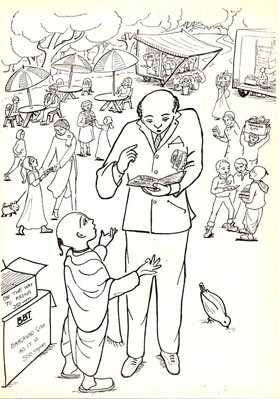 Padayatra always distributes Srila Prabhupada’s books, but many times the effort to distribute spiritual knowledge on a grand scale has been hampered by different kinds of difficulties and troubles, most of which could have been avoided. Watch the book inventory close enough and do not run out of books. Have books in the languages for the local people to read. The books should not be too expensive for the people and they should arrive on time. A good size Padayatra certainly needs a sankirtan coordinator, a devotee dedicated to organize book distribution, someone who makes sure there are always enough of the right books and who can inspire the padayatris to sell more and more of them.
Padayatra always distributes Srila Prabhupada’s books, but many times the effort to distribute spiritual knowledge on a grand scale has been hampered by different kinds of difficulties and troubles, most of which could have been avoided. Watch the book inventory close enough and do not run out of books. Have books in the languages for the local people to read. The books should not be too expensive for the people and they should arrive on time. A good size Padayatra certainly needs a sankirtan coordinator, a devotee dedicated to organize book distribution, someone who makes sure there are always enough of the right books and who can inspire the padayatris to sell more and more of them.
MEET YOUR REQUIREMENTS
1) Sankirtana coordinator:
His/her duties are various:
– Study the best way to distribute as many books as possible on Padayatra: strategy, ordering, finances, vehicles, team, equipment, specific goals, healthy competition, training, prizes for distributors, etc.
– Inspire all the padayatris to distribute books.
– Study the kinds of people they will meet: poor, educated, illiterate, etc.
– Order the right quantity of books in the necessary languages.
– Train other devotees in the field: personally, through seminars, etc.
– Check the supply of pamphlets, invitations, contact sheets, etc.
– Keep a regular inventory of all the books in stock.
– Keep track of book scores:
– Post them on the Information Board.
– Announce them each morning.
– Send them to the Padayatra Newsletter, the BBT book scores bulletin and other ISKCON publications.
– Work with the local BBT for special publications: in India the Tamil Nadu BBT printed a cheap paperback Bhagavad-gita, but only in time for the Padayatra’s last few days in the state.
– Insure that all BBT laksmi is immediately put aside to pay BBT debts and buy more books: otherwise it might merge with the rest of the laksmi and not be available when necessary.
Appendix a: Sankirtana book scores from various padayatras
2) Books and magazines:
– Get books and magarines in all the languages spoken by the people you will meet during your walk:
– Local languages
– Ethnic minorities
-Tourists visiting the area in large numbers
– Order them from the BBT well in advance.
– Get a variety of publications to suit the needs of the distributors and the public:
– Small books are cheaper and easier to carry.
– Large books are great also as gifts to officials, mayors, guests, religious leaders, etc.
– Magazines are light and popular.
– Have books donated by temples.
– Find individual sponsors.
– Make appeals for sponsors in your padayatra newsletter and ISKCON publications.
– Sell “Back to Godhead”, Srila Pabhupuda’s favorite magazine, and enroll new subscribers.
Appendix b: Bhagavad-gita sponsorship ad
3) Sankirtan vehicle:
– Cars, vans, motorcycles, bicycles, etc.
– Besides transporting book distributors to remote areas and villages, vehicles can be used for book storage.
4) Storage:
– Sankirtana vehicle or bus
– Special cart or trailer
5) Book distributor kit:
– Sankirtana bag
– Waterproof if possible
– Keep it clean
– Padayatra fliers and pamphlets for mass distribution
– Sankirtana clipboard
– Title: Padayatra and theme
– Map of padayatra route
– A few color photos of Padayatra: Deities, cart and oxen, camp, festival.
– A few favorable newspaper clippings.
– Contact sheets
– To further cultivate favorable contacts and send them catalogs.
– Invitations to the camp to meet the devotees, attend arati, come to a feast, etc.
– BTG subscription forms
– Show people a sample BTG in the local languages.
– Pens and notebooks
6) Safety for book distributors:
– The public knows that book distributors carry money, and devotees have been attacked in a few poor countries, (India, Biolorussia).
– Book distributors: be careful, don’t be naïve, hide your laksmi, and don’t forget to pray to Lord Nrsimhadeva!
USE DIFFERENT BOOK DISTRIBUTION STRATEGIES
1) Prepare the field:
– Have a party of book distributors travel ahead of Padayatra, distributing books and fliers informing the people about the coming Padayatra. It will notify them of Padayatra’s arrival date, locations of home programmes and festivals, inviting them to attend.
– The annual book distribution marathon book distribution could take place in the areas where Padayatra is scheduled to walk through: the population will be more favorable and receptive when the party arrives.
– Sometimes Padayatra goes through places where lots of books have been distributed by ISKCON devotees. By further cultivating the people there, padayatris are thus continuting the work of the previous book distributors. In Italy a priest who had received a set of books in the past invited that same devotee to speak in his church when he came with Padayatra.
2) Concentrate on the walk through populated areas:
– The Padayatra party with the Deity cart and oxen attracts the most people in cities and towns, especially in the West.
– Stop the cart in a central place for some time.
– Hold a long and enthusiastic kirtan.
– Make a little presentation to explain the purpose of your walk and the basics of the philosophy and the chanting.
– Have many book distributors get in action.
– Distribute Padayatra pamphlets and fliers in great quantity.
Reach out with vehicles:
– Go to places far from the established route with the sankirtan vehicles or take public transportation.
4) Take advantage of festivals and home programs:
– Set up book tables wherever possible.
– Present the books to the public during your program or lecture.
5) Other strategies:
– Put sets of books in local libraries, universities, give to mayors (New Zealand, France, US), religious institutions, prisons, etc.
– In India devotees stopped buses and did not get down until everyone in it got a book.
6) Self-sufficiency through book distribution:
– Sell all the books, do not give them away for free: people will appreciate them more.
– Look at the example of Padayatra India after 1996.
– If you want to give something free, give a pamphlet instead.
7) Take care of the follow-up:
– Contacts
– Have preachers fill out the contact sheets.
– Collect them regularly.
– Make a plan for the follow-up of favorable contacts
– Temple in the area
– Padayatra Office
– Congregational members living in the area
– Send the scores to the Sankirtana Newsletter, Padayatra Newsletter, etc.
APPENDIX
a- Book scores from various Padayatras : India, USA, Europe, etc
b- Bhagavad-gita sponsorship ad in Padayatra Worldwide Newsletter
BOOK SCORES FROM VARIOUS PADAYATRAS
PADAYATRA INDIA
YEAR MONTHS NAME POINTS MAHABIG BIG MEDIUM SMALL MAGS SUB M+BIG 1989 4 Padayatra India 2180.45 45 337 81 3948 11530 0 382 1992 8 Padayatra India 6916.15 2537 7 59 15095 8162 0 2544 1993 12 Padayatra India 5467.45 1775 276 455 9614 10546 0 2051 1994 12 Padayatra India 24045.75 7628 456 100 67880 33600 0 8084 1995 12 Padayatra India 15325.50 6513 575 290 33840 1000 0 7088 1996 12 Padayatra India 41998.70 21665 2611 1644 32430 0 0 24276 1997 12 Padayatra India 30657.75 16230 2713 120 23293 158 0 18943 1998 12 Padayatra India 54285.95 29405 101 0 67253 0 0 29506 1999 7 Padayatra India 35236.55 18494 1583 0 39417 0 0 20077 2000 7 Padayatra India 42675.80 22731 1217 0 51582 0 0 23948 2001 10 Padayatra India 40050.10 20727 6036 0 38564 0 0 26763 2002 7 Padayatra India 17064.25 10017 923 30 10445 0 0 10940
PADAYATRA AMERICA
YEAR MONTHS NAME POINTS MAHABIG BIG MEDIUM SMALL MAGS SUB M+BIG 1989 3 Padayatra Ameri 2261.45 480 982 102 753 11118 0 1462 1990 3 Padayatra Ameri 143.25 35 106 59 81 237 0 141 1991 8 Padayatra Ameri 243.90 68 96 113 106 833 0 164 1992 11 Padayatra Ameri 416.25 21 204 573 251 603 0 225 1993 1 Padayatra Ameri 19.20 0 7 38 0 24 0 7
PADAYATRA EUROPE
YEAR MONTHS NAME POINTS MAHABIG BIG MEDIUM SMALL MAGS SUB M+BIG 1991 6 Padayatra Europ 3335.60 533 1607 1770 3604 5046 0 2140 1992 8 Padayatra Europ 2152.35 440 561 1153 4232 1535 0 1001 1993 5 Padayatra Europ 2410.15 1011 518 1250 1071 300 0 1529 1994 9 Padayatra Europ 6831.95 1702 3149 1036 5021 1198 5 4851 1995 5 Padayatra Europ 2776.80 5 1291 1621 4829 1750 0 1296 1996 3 Padayatra Europ 2366.30 707 853 1292 584 0 0 1560 1997 1 Padayatra Europ 594.00 96 0 0 0 4500 0 96 1998 5 Padayatra Italy 1834.50 715 0 1656 0 176 0 715
ADDITIONAL BOOK SCORES
UK 1991 10 weeks 7500 books and 40,000 pamphlets Ireland 1990 3 months 6000 books New Zealand 1991 3000 books Italy 1991 1 month 1435 books Holland 1991 10 days 2000 books Czech Republic 1995 6 weeks 658 books Poland 1995 7 weeks 3232 books Ukraine 1994 6 days 736 books Moldavia 1995 4 days 716 books Portugal 1995 1 month 1450 books Czech Republic 1998 3 months 4000 books VMP (Parasurama das) 1997 1 month 4596 booklets
| << PREVIOUS | INDEX | NEXT >> |

